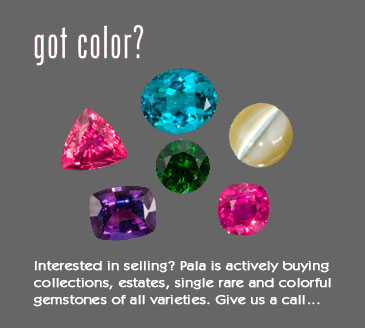gem-news-2013-v3

September – December 2013
- December 2013 Newsletter – December 16
- November 2013 Newsletter – November 18
- October 2013 Newsletter – October 15
- September 2013 Newsletter – September 17
December 2013 Newsletter
To all our clients, suppliers, and readers, Happy Holidays, and thank you for your patronage during the past year. We look forward to serving you in 2014.
Shows and Events
Tucson Time: February 4–16, 2014
After the holidays, we’re looking forward to the world’s greatest gem and mineral show in February. One-stop general information about individual shows can be obtained from the Tucson EZ-Guide.
Pala International will be represented in Tucson as follows. We look forward to seeing our many friends there. Visit the Pala International Show Schedule for future events.
AGTA GemFair
 |
Pala joins nearly 100 exhibitors for this trade-only annual extravaganza.
Event: AGTA GemFair
When: February 4–9, 2014
Where: Tucson Convention Center
Pala International Booth: 1016
The event website now features an interactive floorplan allowing you to see who is exhibiting by area of the convention center.
Free seminars by notables in the world of gemstones and pearls will be listed shortly. Special exhibits this year include
- Displays of the Spectrum Awards winners for gem and jewelry design as well as the finalists of the International Pearl Competition
- The “Magical Gifts of Nature” a new traveling exhibition of Extraordinary and Incredible Cultured and Natural Pearls
- Highlights of the Smithsonian Institution’s Janet Annenberg Hooker Hall of Geology, Gems & Minerals
- Somewhere In The Rainbow – A Modern Gem and Jewelry Collection
13th Annual Westward Look Mineral Show
Pala International and two dozen other world-class mineral dealers shack up at a Sonoran Desert resort.
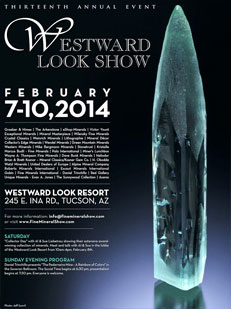 |
- Collector Day (Sat) features Al and Sue Liebetrau and selections from their private collection
- The Pederneira Mine – A Rainbow of Colors (Sun) features Daniel Trinchillo
Event: 13th Annual Westward Look Mineral Show
When: February 7–10, 2014
Where: Westward Look Resort
Pala International Suite: 224, Building 20, Upper Level
See Pala International’s page on the Westward Look Show site. See also this dealer map.
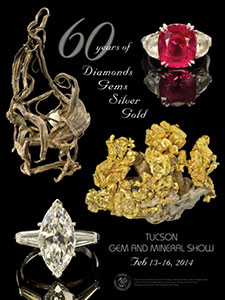 |
60th Annual Tucson Gem and Mineral Show
TGMS is the largest gem and mineral show in the country. This year’s theme is “60 Years of Diamonds, Gems, Silver and Gold.”
Event: 60th Annual Tucson Gem and Mineral Show
When: February 13–16, 2014
Where: Tucson Convention Center
Pala International Booth: Aisle 5 East
[back to top]
Tucson Transit Tips
Many shows will offer their own shuttles. View your transit and parking options here. [back to top]
Tucson Theme Reflected in R&M
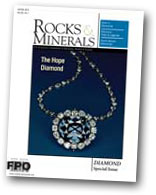 |
TGMS celebrates this time around with a theme, “60 Years of Diamonds, Gems, Silver and Gold,” and the journal Rocks and Minerals is celebrating the celebration with its January-February edition, devoted to the traditional 60th gift: diamond. It features a who’s who of talent: researchers, curators, photographers, collectors, and more—many from the field of gemology as well as mineralogy. See abstracts for the following articles.
- The Tucson Show’s Diamond Anniversary by Robert B. Cook
- South African Diamonds: A Photographic Personal Perspective by Bruce Cairncross
- The Hope Diamond: Rare Gem, Historic Jewel by Jeffrey E. Post and François Farges
- Beyond Hope: Some Other Notable Diamonds at the Smithsonian Institution–Part 1 by Russell C. Feather II
- Coming to Terms with Diamonds: A Matter of Facts by Carl A. Francis and John H. Betts
- Diamond: The Super Mineral by George E. Harlow
- Diamond Legends and Tall Tales by Tony Nikischer
- The Microworld of Diamonds: Images from Earth’s Mantle by John I. Koivula and Elise A. Skalwold
- Color in Natural Diamonds: The Beauty of Defects by Eloïse Gaillou and George R. Rossman
- Collecting Diamonds and the Kimberley Process by John H. Betts and Tony Nikischer
- Connoisseur’s Choice: Diamond, Dutoitspan Mine, Kimberley, Northern Cape Province, South Africa by Paul W. Pohwat
See also R&M editor-in-chief Marie Huizing’s “Chips from the Quarry” column, which includes a list of previous articles the journal has published on the subject of diamond. And for Tucson travelers, Huizing includes a helpful list of events leading up to the main event. You can pick up a copy of Rocks and Minerals in the Ballroom at the Arizona Mineral and Fossil Show in the Hotel Tucson City Center, February 1–11; at the Main Show, which opens on February 13–16; and at the Sunday evening program, February 9, at the Westward Look Show. [back to top]
Gems at GIA
In addition to being a center for learning, research and analysis, the Gemological Institute of America has a gem and jewelry collection, highlights of which are on display at the GIA Museum in Carlsbad, California. Currently exhibited are examples of work by the team of Tony Duquette and Hutton Wilkinson, to which we pointed last July, and fourteen pieces by Austin, Texas jewelry artist Zoltan David, whose floral design is pictured below.
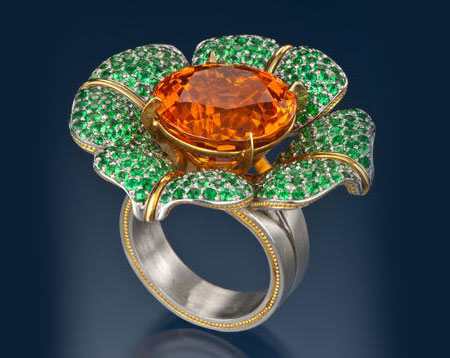 |
| From the GIA collection, a ring by Zoltan David. (Photo: Robert Weldon courtesy of Nancy’s Collection) |
Fifteen sculptures by Peruvian artist Luis Alberto Quispe Aparicio are on display in an exhibit titled “Faces of Eternity.” Aparicio employs various gem materials, including peanut wood agate, labradorite, soap jasper and pink opal.
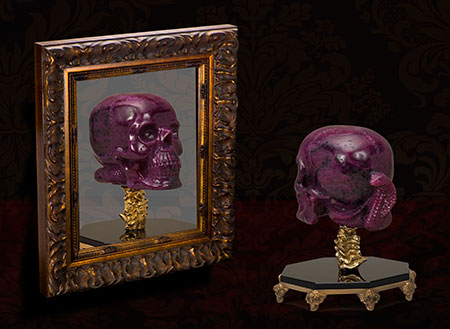 |
| Snake Master is carved from Tanzanian ruby. The base is crafted in gold vermeil and obsidian. Because of its hardness, ruby requires a different and more lengthy process in carving from other materials. Aparicio told GIA, “Stone carving, once you start, is something very addictive.” (Photo: Orasa Weldon courtesy of Luis Alberto Quispe Aparicio) |
Single pieces in the GIA Museum collection beckon as well, like Kabuki Brooch, designed by Bali-based Carolyn Tyler, below. Tyler ran an advertising agency in Southern California before moving to Indonesia where she works with a team of master craftsmen.
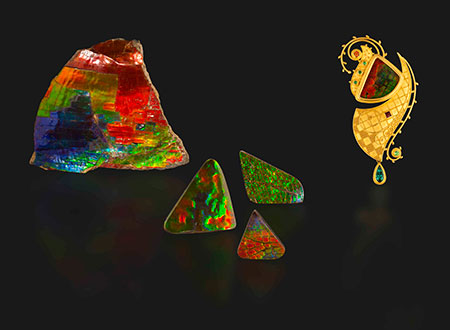 |
| Kabuki Brooch, right, crafted from ammonite, garnet, tourmaline and 22-karat gold. Ammonite has organic origins: fossilized mollusks that died out at about the same time as the dinosaurs. (Photo: Orasa Weldon, gift of Carolyn Tyler) |
These jewels are only a handful of the lovely creations you’ll come across in a visit to the GIA Museum. See the GIA website for more information. [back to top]
Sneak Peek: Cartier at DAM? Brilliant!
It may be nearly a year away, but Denverites and visitors can look forward to a holiday treat next fall with a homegrown show, “Brilliant: Cartier in the 20th Century,” produced exclusively at the Denver Art Museum, as announced last Tuesday. Focusing on the maison’s work from the first eight decades of the 1900s, the exhibition will feature 250 pieces: jewelry, timepieces (including the Egyptian striking clock pictured below) and more, as well as “his” items like cufflinks, cigarette cases, and Cartier’s signature tank wristwatch.
DAM director Christoph Heinrich was quoted in a press release about the scope of the show: “The evolution of Cartier takes us on a journey through 20th century history, from the era of the last Czars in Russia to the Roaring ’20s in America to the onset of Hollywood glamour as we know it.” Heinrich explained to The Denver Post that the museum has never mounted such an ambitious jewelry show, which will include museum-quality creations owned by Elizabeth Taylor and the Duchess of Windsor (and heightened security).
“Brilliant” runs from November 16, 2014 through March 15, 2015. Tickets will be available next summer. Since the show will not travel, you might want to.
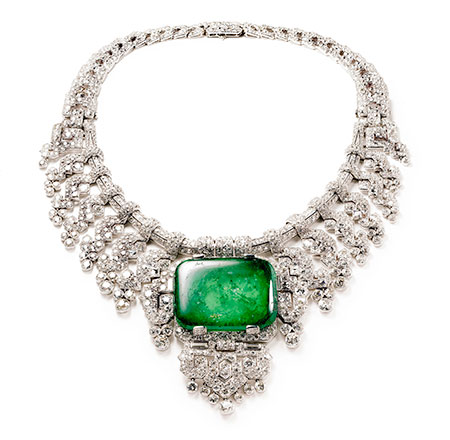 |
| Front and center. Necklace worn by the Countess of Granard, Beatrice Mills Forbes, from a wealthy family that specialized in thoroughbred horse racing. Her brother, Ogden L. Mills, was Herbert Hoover’s treasury secretary. This necklace was a special order crafted in 1932 by Cartier London of platinum, diamonds and emerald. The center stone is a 143.23-carat emerald-cut cabochon. Height at center 8.80 cm. Cartier Collection. Can’t wait for DAM? Catch “Cartier: Style and History” at The Grand Palais in Paris through February 16, 2014, which features some of the same jewels from the Cartier Collection. (Photos: Nick Welsh, above, Cartier Collection © Cartier; Bain News Service, below, undated, courtesy Library of Congress) |
 |
See The Jewellery Editor for a slide show that will provide a perspective on the stunning size of the necklace pictured above. Wrap your mind around the 143.23-carat emerald, were it wrapped around the neck of Countess Granard, above.
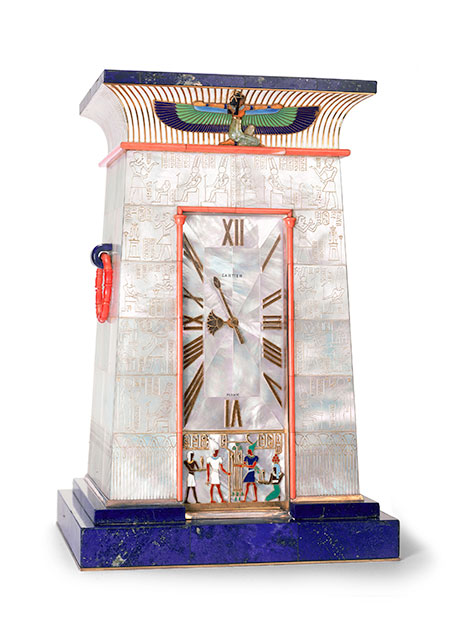 |
| Striking. Egyptian striking clock owned by Florence Meyer Blumenthal (1875–1930), wife of German banker George Blumenthal. She was a patron of the arts whose philanthropy included the Prix Blumenthal, given to about two hundred recipients in arts and letters between 1919 and 1954. This clock, 24 x 15.7 x 12.7 cm, was created in 1927, using gold, silver gilt, mother of pearl, lapis lazuli, coral, emerald, carnelian, and enamel. Cartier Collection. (Photo: Nick Welsh, Cartier Collection © Cartier) Tick-talking like an Egyptian. Any budding Egyptologists out there? We’d love to know whether the hieroglyphics are but the gibberish of the signer at Nelson Mandela’s memorial. Click for hi-res. |
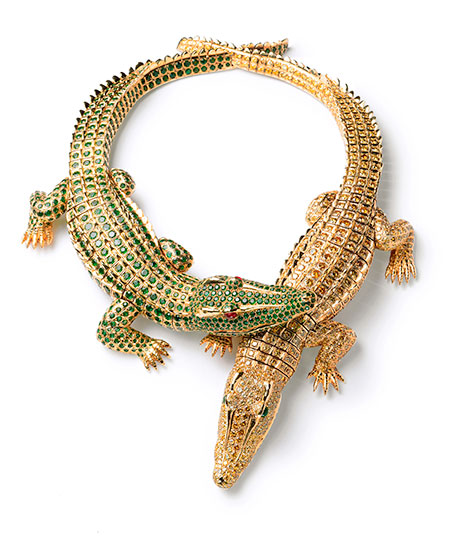 |
| Crocs. Crocodile necklace worn by Mexican actor María Félix (1914–2002), pictured below, who eschewed Hollywood yet made films with everyone from Miguel Zacarías and Fernando de Fuentes to Jean Renoir and Luis Buñuel. The necklace is completely articulated, crafted from gold, two ruby cabochons, 1,023 yellow diamonds (60.02 tcw), and 1,060 emeralds (66.86 tcw), measuring 30 cm and 27.3 cm in length. When worn as a brooch, the tucked-in legs of each segment are replaced. It is said that Félix dropped off her own pet crocodile to serve as model, but cautioned that her baby was growing. It took two years to create the necklace. Cartier Collection. (Photo: Nick Welsh, Cartier Collection © Cartier) La Doña. Below, it appears that Cartier engaged in some crocodile cannibalism, issuing in 2006 its La Doña de Cartier collection, the watch from which features scale-like band and croc-like trapezoidal case and face. Marketing included color images of a Félix stand-in. Like Countess Granard, Félix was involved in thoroughbred horse racing, by way of her last husband, French banker Alex Berger. |
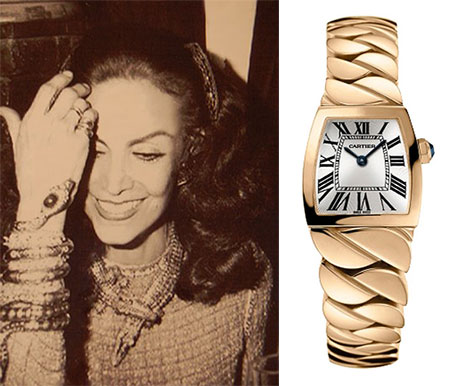 |
[back to top]
Pala International News
Pala’s Featured Stone: Pearls, 3 + 1
This month we feature a little batch of some big scallop pearls and an exceptional oyster pearl…
We were in luck this month as our Mexican pearl broker passed through the office with a large and impressive selection of natural pearls from Baja California. It seems they have hit a new bank of oysters and other mollusks that is producing some of the largest scallop pearls and some of the finest oyster pearls we have seen.
The first scallop pearl, or “lion’s paw” (below left, Inv. #21517), is an 18.97-carat drop with an intense purple top, blending into a white bottom. A very striking and impressive piece; the morphology is perfect for a pendant. This natural pearl is from the Pectinidae family. The second scallop pearl (below right, Inv. #21518) weighs in at a whopping 21.52 carats, and looks like a mini Jupiter, with swirls and bands of purple, mauve, pink and yellow. Full of character, with a pleasing blend of hues. This pearl is from the Spondylus calcifer species. The third scallop (Inv. #21539) is the 18.97-carat’s little sister, half the size, at 10.55 carats, with more lavender, yellow and light blue hues. A perfect accompaniment to the 21.52-carat, making a nice pair for a ring and pendant.
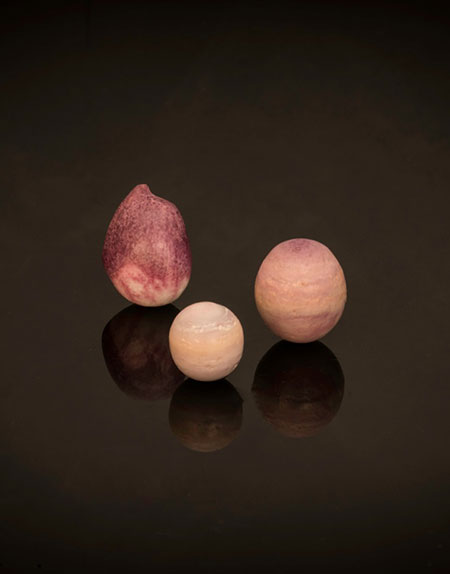 |
| 3 + 1. Above: this trio of pearls is from scallops. Below: this pearl is from a black-lipped oyster. (Photos: Mia Dixon) |
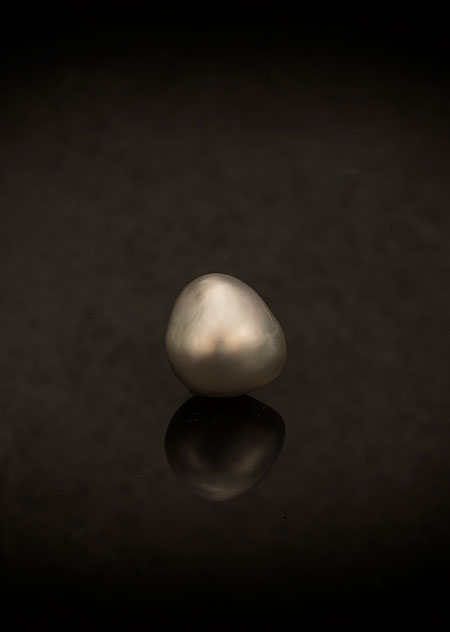 |
The fourth and most outstanding pearl is a 17.57-carat Calafia oyster pearl, also know as the La Paz oyster pearl and Pinctada mazatlanica. This species has been found from the Gulf of California all the way down to Peru. Its natural beauty rivals the finest of the cultured Tahitian pearls you see on the market, with a steely silver base featuring overtones of green, pink, blue…bringing it the appearance of peacock coloration. Price available upon request.
See our previously featured scallop pear. And compare with Radiant Orchid…Pantone Color of the Year 2014.
Interested? Select inventory numbers above, call (phone numbers below) or email us to inquire. [back to top]
Pala National
Mia Dixon waves the red, white and blue
Last month, Mia Dixon, Pala International’s resident photographer became more than a permanent resident of the USA. Mia, a native of Sweden, became an American citizen as she gave the Oath of Allegiance.
Congratulations, Mia!
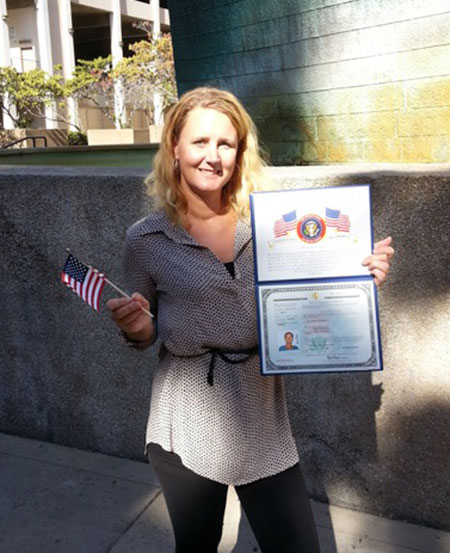 |
| All doc-ed out. On the other side of the camera, for once, Pala International’s Mia Dixon stands with documentation of her citizenship. |
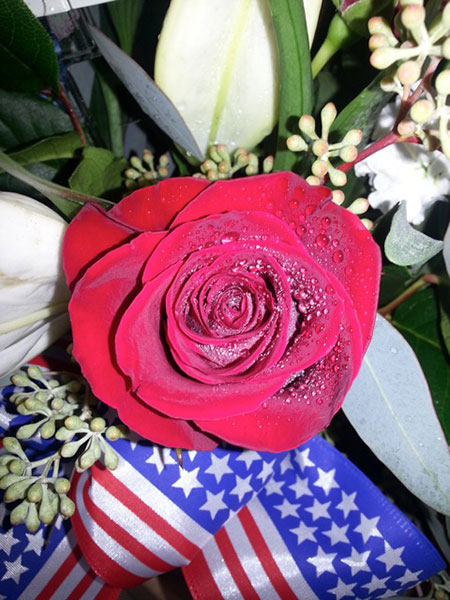 |
| Trading glögg for nog? Mia Dixon was congratulated by Pala people with a red, white and blue bouquet, upon receiving American citizenship. |
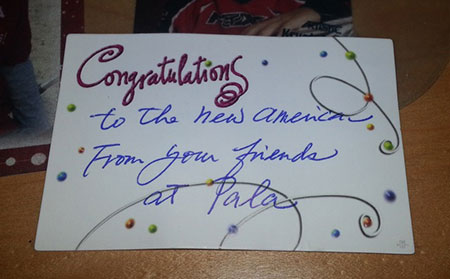 |
[back to top]
Roll Away the Stone
Bill Larson received his own congratulations when, not long before Thanksgiving, he experienced his own Easter. It seems that while he was driving to the West Coast Gem & Mineral Show in Santa Ana, word of his demise had been posted online by a somewhat disoriented V.H.
We lost a true Icon of our Industry when we lost Bill Larson.. RIP http://store.palagems.com/burma2013.htm
Bill Larson in Burma 2013
store.palagems.com
Bill Larson travels to Burma and the Mogok Valley.
Dealer Rick Kennedy saw the post and collector Jon Sigerman tried to call, but Bill was on the 15 freeway. “When I showed up at the show,” he told us, “five people were relieved I was alive.” He quickly added, “Probably more were sad I wasn’t dead.” And, yes, he got some mail…
 |
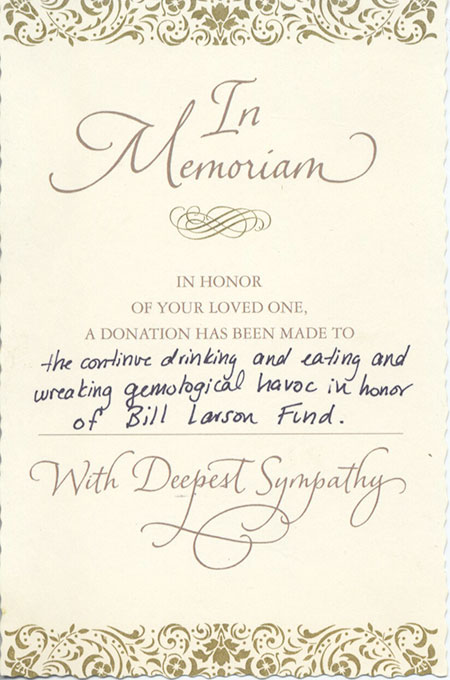 |
[back to top]
Gems and Gemology News
Crystal Gazing
The International Year of Crystallography brings with it a few other shards worth sharing…
2014 International Year of Crystallography
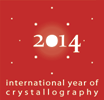 |
The International Year of Crystallography (IYCr2014) is a testament to the importance of crystallography in our lives. For gemologists, that’s a given. But the organizers explain that crystallography has a “fundamental role for the development of the different branches of science: chemistry, mineralogy, physics, biology, medicine, materials science, cultural heritage, geoscience” and more, and that crystallography has a “pervasive presence in everyday life.”
To bring these points home—or abroad—, educational exhibits will travel to Africa, Asia and Latin America. Each region will have a hub from which the exhibition will travel to universities together with instructors. About a dozen activities are included in the exhibition. Other events are scheduled around the world (list-able by country, date and category). There’s a slew of virtual learning opportunities, including visual information and exhibitions, audio and video clips, games, computer applications, and more.
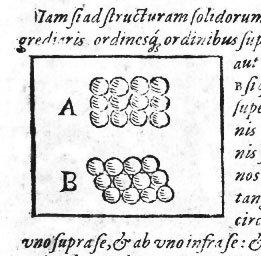 |
| Stacked; packed. This figure from Kepler’s treatise illustrates his postulate on packing. It is included in Wikipedia’s entry on X-ray crystallography. |
IYCr2014 also is a commemoration of two events. First, Johannes Kepler’s De nive sexangula (On the Six-Cornered Snowflake, 1611), written with a “playful and probing” spirit, as characterized by Paul Dry, publisher of a new translation. In late 1610, as he walked across Prague’s Charles Bridge, Kepler took note of the six-rayed, six-cornered nature of snowflakes. London-based writer Philip Ball, in a December 2011 essay regarding Kepler’s brief, 24-page treatise, stated that “[t]his charming, witty work seeded the notion from which all of crystallography blossomed: that the geometric shapes of crystals can be explained in terms of the packing of their constituent particles.” Yet it wasn’t until 1998 that (what’s now known as) the “Kepler conjecture” regarding that packing—i.e., hexagonal packing offers the tightest arrangement—was proven. Ball also notes that René Just Haüy benefited from Kepler’s thinking; so the father of modern crystallography seems to have had a stepfather.
The second commemoration regards the hundredth anniversary of X-ray diffraction, a method for detailed crystallographic study. Building upon the work of Max von Laue (who had discussed the challenge with Paul Peter Ewald), father-and-son physicists William Henry and William Lawrence Bragg theorized and then proved, via X-ray spectrometry, that crystalline material could be identified due to fingerprinting at the atomic level.
Virtual Museums Offer Educational, Eye Candy
The Virtual Museum of the History of Mineralogy is one of a few dozen resources included in the IYCr2014 educational page. The museum is always worth a browse or two. To find what’s new, read the December 2013 newsletter.
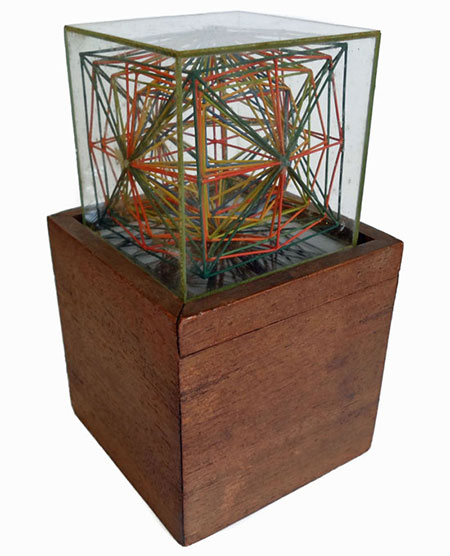 |
| Glass and wire model, 19th century, maker unknown. Glass cube, edge 66 mm. Inside the cube, 9 cubic crystal forms delineated by colored wires are present; three 6-faced, five 24-faced and one 48-faced models. The model comes in a red plush lined mahogany case. From The Tricottet Collection, courtesy of A. Mignan. |
One new item, pictured above, comes to the museum via The Tricottet Collection, which features yet another virtual repository of objects of interest. The Virtual Museum’s Paul Tambuyser told us that the wire model would have been used “to compare different cubic crystal forms and their relation to one another.”
Established in 2006 by Dr. Arnaud Mignan, grandson of Guy Tricottet (1926–1993), The Tricottet Collection aims to preserve items of historic natural history [sic]. The collections consist of three halls—Minerals, Life and Meteorites; special stand-alone collections; libraries, including a library of meteorites; archives, including biographies, labels, manuscripts & correspondence and images; and the cabinet of curiosities. Regarding this last component, in his essay on Kepler (cited above), Philip Ball credits these cabinets (Wunderkammern), or in particular one of the many owned by Holy Roman Emperor Rudolf II (1552–1612), with holding a dodecahedron that might have inspired Kepler in his work on crystals. (These cabinets were, loosely, the antecedents of museums. Visitors to Los Angeles can take in a museum itself devoted to such curiosities, the naughtily named Museum of Jurassic Technology, about which Lawrence Weschler penned Mr. Wilson’s Cabinet of Wonder.)
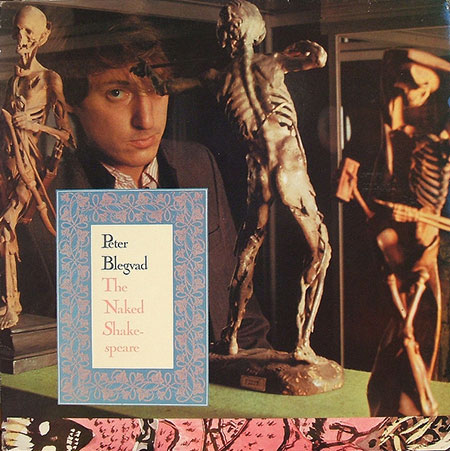 |
| American musician Peter Blegvad, raised in Connecticut and England, stands beside a cabinet of wonder in the cover photo for The Naked Shakespeare, his first solo LP, released thirty years ago this October. Blegvad for a time worked with the band Henry Cow, which in 2009 released a 40th anniversary box set, buyers of which were given a bonus CD, A Cow Cabinet of Curiosities, featuring Blegvad on one track. |
Crystal Gold Mine
We thought we’d toss this in for fun. C-SPAN and mine owner Ray Cropp take you through the day of a hard rock miner in twelve minutes.
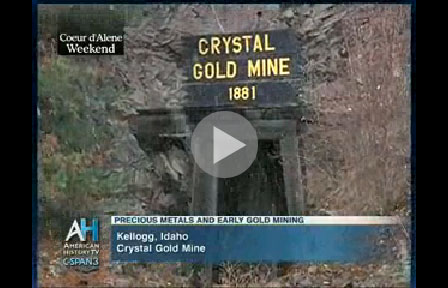 |
Jeepers Creepers
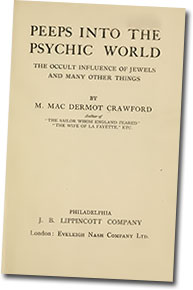 |
“The superstition that certain jewels attract misfortune to their owners is so rarely questioned that it has become an accepted belief….” With this, Bay Area-bred expatriate author Mary MacDermot Crawford begins her book Peeps Into the Psychic World: The Occult Influence of Jewels and Many Other Things, published nearly one hundred years ago (available here). Whereas Crawford was the biographer of American naval hero John Paul Jones (1913) and of Adrienne de La Fayette (1907, 1908), wife of the American Revolutionary War general, in 1915 she turned her gaze to the psychic realm. Unconvincingly, she begins the book (only the first 45 pages of which really deal with the subject of its title) by turning to fiction, in the case of opal, to which the “taint of ill-luck clings,” by synopsizing Sir Walter Scott’s Anne of Geierstein, in which Hermione the Persian is rendered “a little heap of ashes” after a drop of holy water meets the “superb” opal of her hair clasp. Crawford then recounts how opal was prized in classical times, and how Queen Victoria gave these stones as wedding presents. Even the opals in Crawford’s collection had, “as yet, brought nothing but good luck. However….” And on and on. Worth a gander into the thinking of one post-Victorian mind and the sort of stuff being written not long before Hermann Hesse, in his own novel The Glass Bead Game, would label our era of attention-deficits the Age of the Feuilleton (i.e., the magazine).
Thumbnail Specimens
Finally, we return to Kepler’s snowflakes, but what he viewed with the nearly-naked eye now is being captured by photographer Alexey Kljatov for our delight. Kljatov, a Muscovite who goes by the handle ChaoticMind75 on Flickr, uses a super-macro camera setup (technique explained and illustrated here).
 |
Klijatov is not alone in his pursuits. He credits Wilson Bentley with being a pioneer of snowflake photography. And he points to Ontario-based photographer Don Komarechka, author of the newly published Sky Crystals, perfect for gift-giving. In his blog, Komarechka began on December 1 to post a flake a day. Our favorite is Day #4: a split-plate crystal that forms from a column-type. [back to top]
Industry News
China MIA: Market, Industry, Art
As a follow-up to last month’s nod to the Changsha show, we point to several items published recently by GIA on China, its market, its industry, its craftsmanship.
First, GIA senior industry analyst Russell Shor notes the skyrocketing demand for jadeite amongst wealthy Chinese buyers. Supply from Burma, however, has dropped, and the country’s regular gem auctions have been suspended due to armed fighting in jade land. Yet what has been produced isn’t getting into the market. Adding to a challenging situation are predictions that, even at the current rate of slowed production, reserves could be kaput in ten to twenty years. Read the full report here.
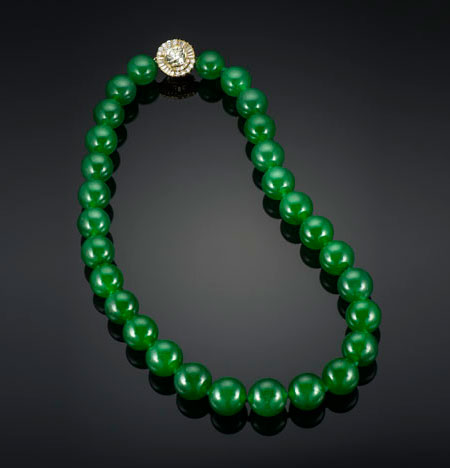 |
| This necklace contains 29 matched imperial jadeite beads ranging from 14 to 16.6 mm with a 2.34-carat diamond in the clasp. The necklace was displayed at this September’s Hong Kong show accompanied by a sign that explained it was not for sale. When a visitor suggested it might fetch $10 million, Stanley Chu of the firm that owns it stated, “More. Much more.” (Photo: Robert Weldon, © GIA, courtesy of On Tung Co., Hong Kong) |
Next, a team from GIA visited China this past summer “on a quest to learn about the gem and jewelry industry there and its significance in the global industry.” They started out at June’s Hong Kong Gem and Jewellery Fair, then on to seven cities to visit factories, trade centers and organizations, government agencies and retail outlets. Reports will be issued in the coming months. See the project overview and the “story behind the story.”
First fruits from the project come in the form of “Filigree Inlay Art: The Intangible Cultural Heritage of China,” by Gems and Gemology technical editor Tao Hsu (a Beijing native) and Andrew Lucas, manager of Field Gemology. The article (in English and Mandarin) is beautifully illustrated with examples of the art, and is accompanied by five streaming videos documenting various aspects of the filigree technique. [back to top]
Burma Bits
Vice President of Myanmar Women Entrepreneurs
Calls for Value-Added Goods
Just above in our newsletter, we pointed to a report from GIA’s Russell Shor that discusses Burma’s enigmatic shortage of jade. Also discussed in that report are Burma’s efforts to set up local jadeite carving and polishing operations, instead of sending raw material abroad. A week ago, The Irrawaddy published an interview with Thet Thet Khine, vice president of Myanmar Women Entrepreneurs Association who, when asked what she’d do to change economic policy if she were a member of parliament, answered, “Our country is full of natural resources, so the government shouldn’t sell out raw gems to foreign countries while they need money. We should produce value-added goods.” Presumably this notion comes from her experience as managing director of the gold and jewelry firm Forever Gems. She continued by mentioning the trickle-down effect such a policy would have.
In fact, Burma’s foreign trade neared $16 billion in the first nine months of the 2013–14 fiscal year, up nearly $4 billion from the same period last year, according to a story yesterday by Eleven Media Group. Border security is credited for some of that jump. Value-added goods, while benefiting on the one hand, face the challenge of tariffs with a trading partner like China.
Jade extraction may have been hampered by unrest in Kachin state, but people in Yangon/Rangoon attended an event that was seen as a move in the right direction regarding the armed conflict, as reported by The Irrawaddy on November 20. Kachin Independence Army deputy chief of staff, Gen. Sumlut Gun Maw, addressed a packed crowd in a Baptist church, discussing any prospects for a ceasefire, just as 2,000 villagers in Kachin were fleeing the fighting. Gun Maw also urged that Burma’s constitution be amended, giving greater autonomy to minorities. The fact that he was allowed to travel to Yangon was seen as a sign of trust, however feeble, between the warring parties.
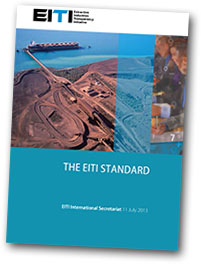 |
In his report, Russell Shor mentions the challenge faced by Burma of too-speedy extraction of jade. A potential impact on this issue is the fact that Burma is taking steps to join the international standard known as the Extractive Industries Transparency Initiative, or EITI. The initiative requires the following.
- Effective oversight by the multi-stakeholder group.
- Timely publication of EITI Reports.
- EITI Reports that include contextual information about the extractive industries.
- The production of comprehensive EITI Reports that include full government disclosure of extractive industry revenues, and disclosure of all material payments to government by oil, gas and mining companies.
- A credible assurance process applying international standards.
- EITI Reports that are comprehensible, actively promoted, publicly accessible, and contribute to public debate.
- The multi-stakeholder group to take steps to act on lessons learned and review the outcomes and impact of EITI implementation.
As reported by Xinhua yesterday, a preliminary meeting was held in Yangon on Sunday, as part of “strenuous efforts” to join EITI. The meeting was attended by Burma’s EITI Office leaders and entrepreneurs in the areas of minerals, gems and jewelry, and gold. [back to top]
Recycle Bin
Below are recent items from our sibling publication, Pala Mineralis, that will be of interest to colored gemstone enthusiasts.
An American in Paris
Pala International’s Bill Larson spent time in Paris with son Carl Larson, just in time to take in the Paris International Mineral Show. More…
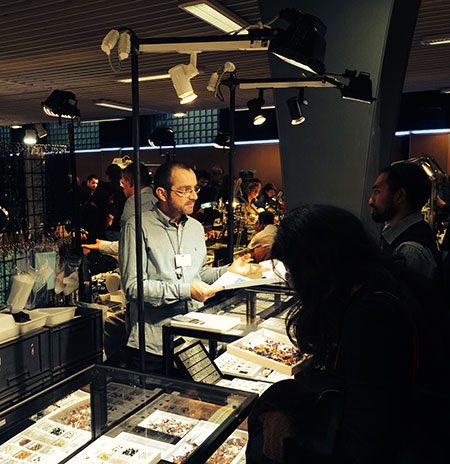 |
| Fall colors. Despite the show’s name, it also features colored gemstones and jewelry. Above, gem and mineral dealer Denis Gravier. (Photo: Carl Larson) |
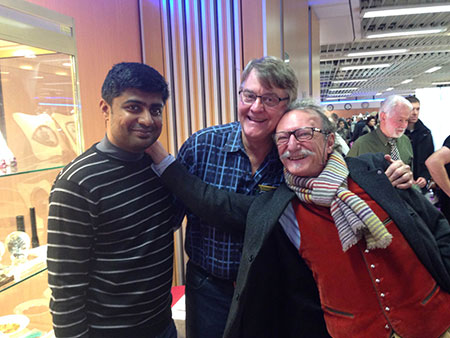 |
| From left, Indian dendrite dealer Tarun Adlakha (whose offerings are shown within), Pala International’s Bill Larson, and Gian Carlo Parodi of the Musée d’Histoire naturelle in Paris. (Photo: Carl Larson) |
[back to top]
Rubies from Montepuez
Vincent Pardieu has been writing about rubies from northern Mozambique for years. In the fall of 2008, he received word from his friend and Tanzanian gem dealer, Abdul Msellem, about new rubies being traded at a market near Winza. They were sourced in Niassa Province, Mozambique, and Pardieu was able to access them in Chantaburi, Thailand. By March 2009 he had released a report on the material via GIA Bangkok, where he manages the Field Gemology Department. The stones were lusciously red and pink, and six months later he visited the locality.
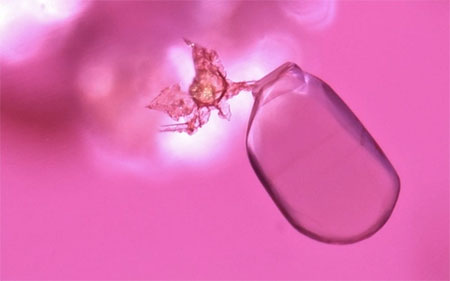 |
| Frosty fringe. A transparent rounded transparent crystal (identified by Raman as amphibole using the RRuff database as a reference) associated with a smaller hexagonal crystal (identified by Raman as mica using the RRuff database as a reference), which itself is associated with frosty fringes in GIA reference sample number 100305163842, an F type sample obtained in Thailand in January 2013 in a parcel of “Bo Nam” rough. Darkfield + fiber optic illumination, magnified 112.5x. (Photo: Jonathan Muyal © GIA) |
Five years later, Pardieu has tied together various field reports and G&G Gem News International items into an 80-page study on another ruby-producing locality in the region—Montepuez. In “Rubies from the Montepuez Area (Mozambique),” he and coauthors Supharart Sangsawong, Jonathan Muyal, Boris Chauviré, Laurent Massi, and Nicholas Sturman cover the following.
- Location and access
- Geology
- Description of the rough
- Materials and methods, including sample fabrication and instrumentation
- Nearly twenty pages of studies of reference samples, including trace element variations between the localities various mines
- Inclusions and conclusions
- Bibliography
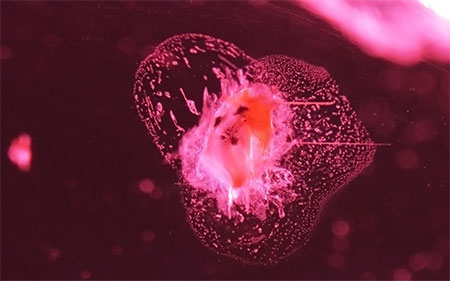 |
| Ruby reef. Not all mica crystals are associated with frosty fringes in Montepuez rubies. In some cases they are found in association with healed fissures reminiscent of those found in heated stones; however the absence of the “atoll like” rim commonly associated with altered inclusions in heated stones is not present in this unheated ruby. GIA reference sample number 100305163841, an F type sample obtained in Thailand in January 2013 in a parcel of “Bo Daeng” rough. Darkfield + fiber optic illumination, magnified 50x. (Photo: Jonathan Muyal © GIA) |
Since its discovery, during the spring of 2009, rubies from Montepuez have dominated Thailand’s ruby trade. And Thailand dominates the world’s ruby trade. And this study likely dominates the discussion of its subject. Enjoy…
 |
| Common dominators. Two natural rubies from Mozambique. Above, 2.10-carat emerald cut, Inv. #21396. Below, 2.53-carat oval cut, Inv. #21395. (Photos: Mia Dixon) |
 |
[back to top]
— End December Newsletter • Published 12/16/13 —
November 2013 Newsletter
Shows and Events
- Gemology Bears Triumphant Tidings at GSA
- Munich Show in Pictures
- Naples’s Treasure: Masterpieces of the Saint Januarius Museum
- A Quest for Beauty: The Art of Van Cleef & Arpels
- Jewels by JAR at the Met
- Changsha: Let a Thousand Museums Bloom
Pala International News
Gems and Gemology News
Industry News
Pala Presents
Shows and Events
Gemology Bears Triumphant Tidings
Elise Skalwold reports from the Historic 125th Anniversary Annual Meeting of the Geological Society of America
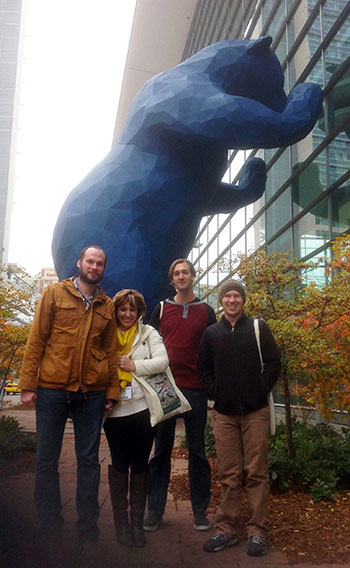 |
With its first-ever dedicated session and with the sponsorship of the Gemological Institute of America (GIA), gemology made significant progress towards recognition as a formal science by the mainstream geo-sciences community during this fall’s Geological Association of America’s (GSA) historic 125th Anniversary Annual meeting held October 27–30, 2013, in Denver, Colorado.
Founded in 1888 in Ithaca, New York, the GSA is one of the oldest and most important geo-science professional organizations world-wide. This year’s huge gathering of over 8,000 people in Denver’s immense Colorado Convention Center was auspicious in many, many ways, not least of all for those whose interests are rooted in the science of gems.
Under the enigmatic gaze of a 40-foot-high blue bear peering through the Center’s glass façade, conference delegates were offered a mind-boggling selection of sessions in which to participate, each comprised of dozens of oral presentations and poster presentations covering a wide range of important developments and cutting-edge research in the geological sciences.
Read the full report here. [back to top]
Munich Show in Pictures
The Munich Show was held October 25–27 this year. Pala International shared selling space with Alain Martaud Minéraux as well as display space with “Gold,” this year’s special exhibition. Pala’s contribution was the “Christmas Tree,” one of the finest gold specimens in the world. The specimen will be included in the forthcoming book, Gold for Collectors, by Joaquim Callén and Eloisa Artola.
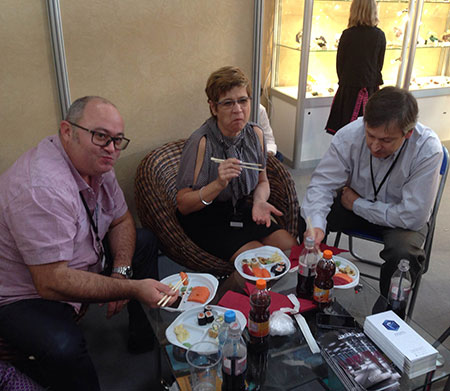 |
| No Burgundy? The Larsons come to Munich for the specimens, yes, but also the spread of Laurent Thomas (Polychrome Minerals, left). Last year it was chèvre and Burgundy, this year sushi and sashimi, Coca-Cola and Freeway MixxMax (cola and orange, a European specialty). (Photo: Carl Larson) |
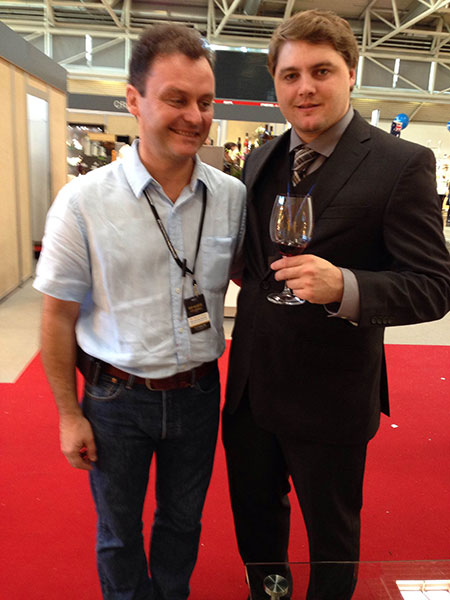 |
| Above, Pala International’s Carl Larson has found Laurent’s stash, as Cristiano Ferraris, from the Musée d’Histoire naturelle in Paris, casts a covetous eye. Carl has been examining the museum’s collection of René Just Haüy, the père of modern crystallography, comparing the collection’s labels and their data against his own inspection. Below, Cristiano has found his own supply during the superb Oktoberfest Party at the table of Bill Larson, left, with the museum’s Gian Carlo Parodi. Note drinks in both their hands. Now Carl has all he needs to blackmail his bosses… (Photos: Carl Larson) |
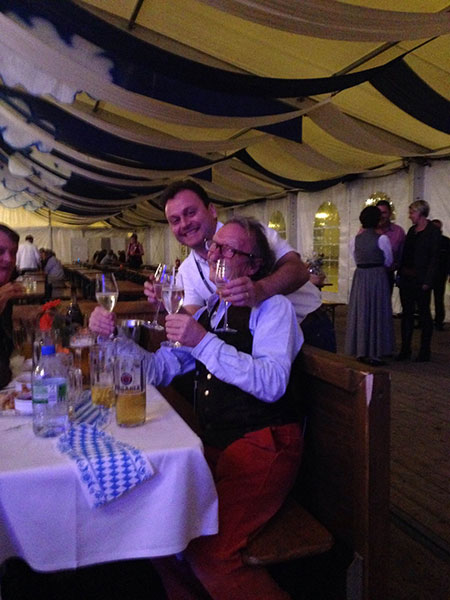 |
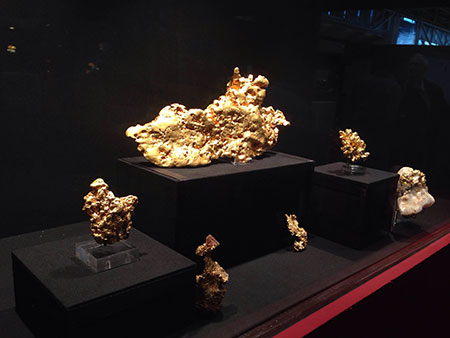 |
| “Gold” was this year’s special exhibit at the Munich Show. Above, some examples of the fine specimens displayed. Below, Pala International’s Will Larson nearly pops a stitch as he holds the “Ausrox Gold Nugget”—although “nugget” seems a bit of an understatement for the world’s third largest, at 23.26 kg, 22 x 24 x 16 cm. (Photos: Carl Larson) |
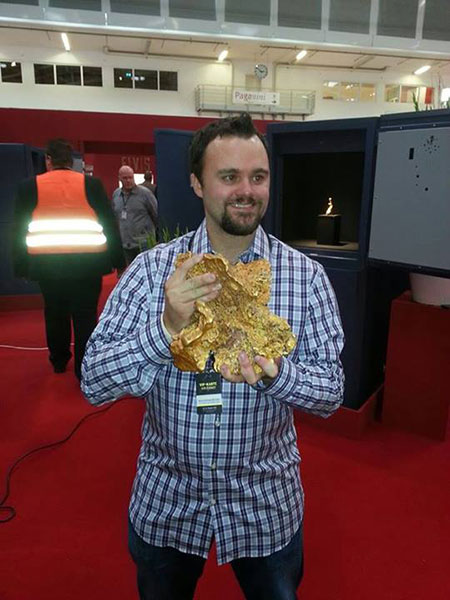 |
 |
| Solid Gold. What would “Gold” be without a little gold lamé, courtesy the King? Below left, Elvis Presley’s TCB logo (“Taking Care of Business”) fashioned into a necklace. Center, the gold record for the single “Kiss Me Quick,” which Presley recorded in 1961 with the Jordanaires. This particular gold record was issued for 20,000 singles (RCA 41.541) sold in South Africa. Right, Presley’s famous concert glasses, also featuring the TCB logo on the temples. These likely are not originals, but rather the sort that are sold by the official store. (Photos: Carl Larson) |
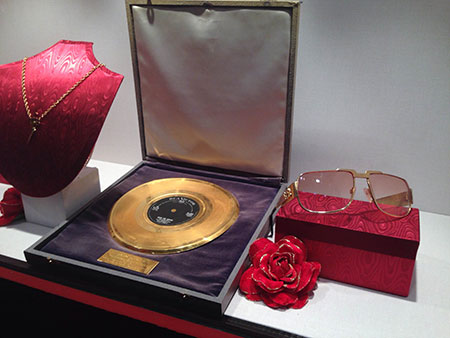 |
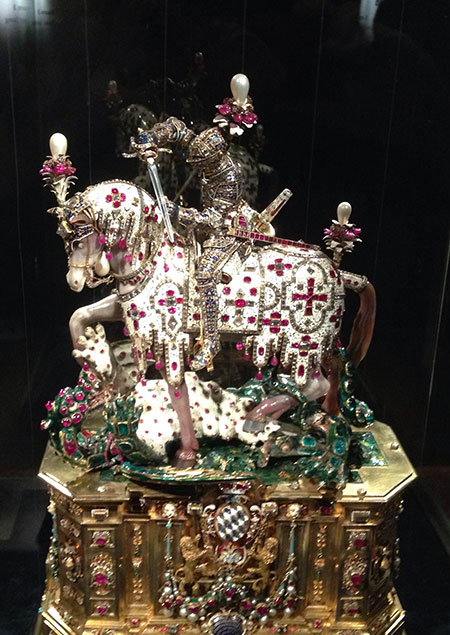 |
| Statuette of St. George, 1586/97, height 50cm, Munich. This is one of the great highlights of the Munich Residenz Treasury. An armored St. George sits astride an opal-eyed horse carved from chalcedony. The knight’s armor and the horse’s caparison, or covering, are delicately enameled and encrusted with rubies, sapphires, diamonds, rock crystal, pearls and more. The green-scaled dragon is decorated likewise, with the addition of emeralds. The saint’s visage—revealed beneath a movable visor—is carved from boxwood in the likeness of the object’s commissioner, Duke Wilhelm V of Bavaria. It was crafted to house a relic of the saint, which Archbishop Ernst of Cologne sent to his brother, the Duke, in 1586. Click images to enlarge. (Photos: Carl Larson) |
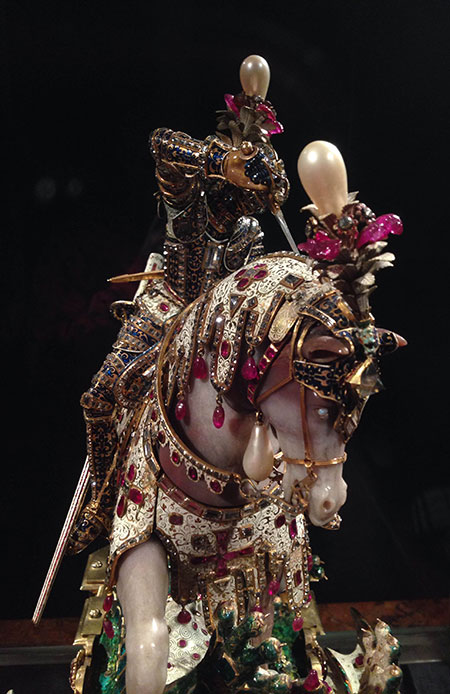 |
For more photos from the Munich Show, see MinBlog from the Natural History Museum of Los Angeles County. [back to top]
Naples’s Treasure: Masterpieces of the Saint Januarius Museum
Fondazione Roma Museo, Rome, through February 16, 2014
Back in the late 1970s, your editor visited New York City for the first time (from Los Angeles), hoping to take in some of the iconic rock bands that were pushing the envelope at the time. A taxi deposited me in Little Italy in the midst of the neighborhood’s San Gennaro Festival. I had my first calzone and my first elbow-to-elbow experience walking through the jam-packed stalls. Who is this San Gennaro that he could bring the bridge-and-tunnel people (including myself, lodging in Jersey) to Mulberry Street to celebrate during the ten days straddling his September 19 feast day?
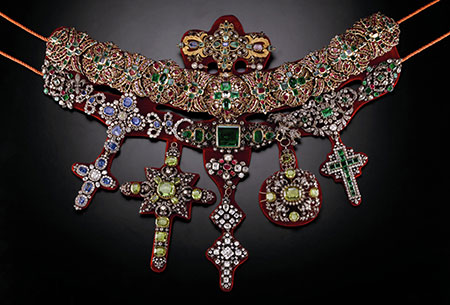 |
| Necklace of San Gennaro above (click to enlarge), in gold, silver and precious stones, created by Michele Dato in 1679. From the exhibition, “Naples’s Treasure: Masterpieces of the Saint Januarius Museum.” The necklace is meant to adorn a bust of the saint. It is composed of jeweled crosses that were stand-alone beauties in their own right and originally took five months to craft. Other crosses and brooches from the 18th century were added later. It also includes a ring given as an afterthought by Queen Marie Josè, consort of Umberto II, and an emerald cross from Napoléon. Below, Napoléon’s own collection of jewels, paintings, sculpture, books, furniture and more currently is on display at the Frazier History museum in—get this—Louisville, Kentucky, in an exhibition titled “The Eye of Napoléon” through February 9, 2014. (Photos: Above, courtesy CLP Relazioni Pubbliche for Fondazione Roma Museo; below, Martin Del Pozo, courtesy Exhibits Development Group) |
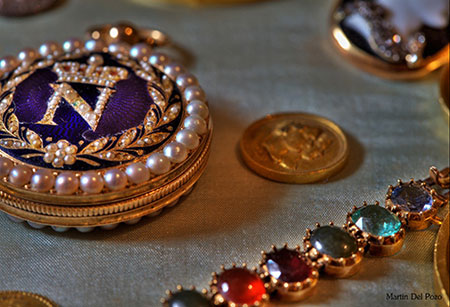 |
Gennaro, or Januarius, was born in the 3rd century in Naples or nearby Benevento. The legend is that, as Bishop of Naples, he hid fellow Christians during the last wave of their persecution by Romans, but to no avail. He was arrested when visiting Sossius, Deacon of Misenum (in the Bay of Naples), in jail. These two future saints were thrown with others to wild bears in the Flavian Amphitheater, so the story goes, but the beasts became Teddy bears in the men’s company. Instead, Januarius and company were beheaded, thus beginning another legend, as related in Glenway Wescott’s Calendar of Saints for Unbelievers:
To this day, three times a year, his dried blood liquefies when the two antique crystal goblets in which it is kept are brought near his cut-off head—either an anomaly in nature or an ecclesiastical secret particularly well-kept.
An article in Italy Magazine recounts how vials of Gennaro’s blood were “exposed” in 1631 during an eruption by Vesuvius, stopping the lava in its tracks, and sparing Naples. A century earlier, as reported by the BBC, Neapolitans vowed to build a chapel to the saint, housing the treasures that had been donated in his honor, in return for his protection. Between 1305 and the present, the number of items in the San Gennaro collection has grown to 21,610 pieces, according to Paolo Jorio, curator of an exhibition in Rome, “Naples’s Treasure: Masterpieces of the Saint Januarius Museum.”
Only about seventy of the masterpieces, now housed in Naples’s Museo del Tesoro di San Gennaro, are on display, but they speak to why the collection is considered perhaps more valuable than the jewels of the Russian czars or the British Crown Jewels. (An Italian-language catalog of the exhibition has been published.)
Gennaro would become the most popular Roman Catholic saint in the world. An exhibition press release states that his devotees number 25 million (and I think each and every one of them were there with me on Mulberry Street that September day three decades ago).
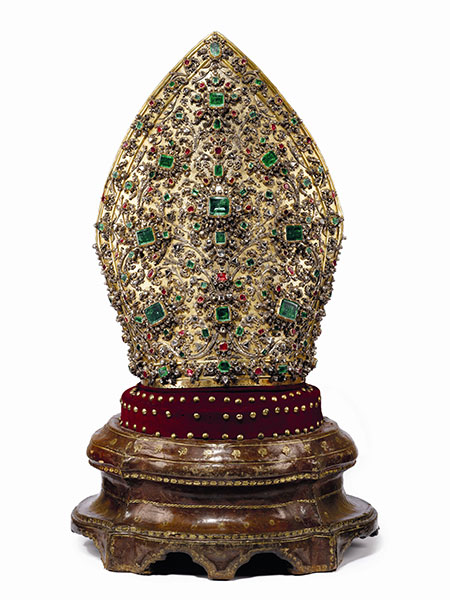 |
| Miter (click to enlarge) by Matteo Treglia, celebrates the tricentennial of its creation in 1713, when it first was placed on the bust of San Gennaro. It is adorned with 3,964 precious stones such as diamonds, rubies and emeralds. This is not simply a display of ostentatious tribute; per the exhibition press release, the miter was crafted “according to the traditional construction of ecclesiastical items in relation to the symbolic meaning of the gems: emeralds represented the union between the sanctity of the Saint and the emblem of eternity and power; rubies the blood of martyrs and diamonds an irreprehensible faith.” The emeralds hail from “ancient quarries in Latin America.” (Photo courtesy CLP Relazioni Pubbliche for Fondazione Roma Museo) |
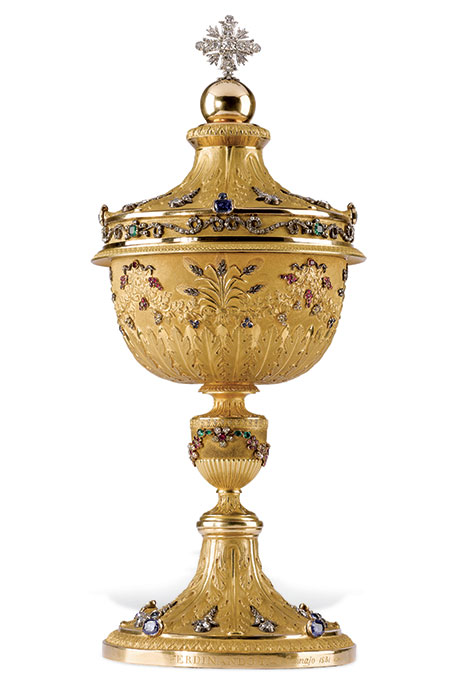 |
| Pyx with jeweled cross above (click to enlarge), in gold, rubies, sapphires, emeralds and diamonds. The delicacy of its design is a fine contrast to that of the miter. It was offered by King Ferdinand II in 1831 and is of Neapolitan manufacture. Episcopal Cross below (click to enlarge), also of Neapolitan manufacture, features gold, emeralds and diamonds. It was given in 1878 by King Umberto I and Queen Margherita of Savoy. (Photos courtesy CLP Relazioni Pubbliche for Fondazione Roma Museo) |
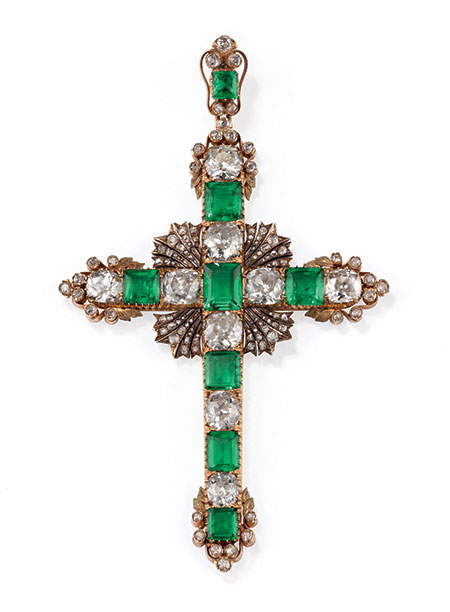 |
[back to top]
A Quest for Beauty: The Art of Van Cleef & Arpels
Bowers Museum, Santa Ana, CA, through February 15, 2014
Pala International’s Bill Larson provided the following remarks in response to “A Quest for Beauty: The Art of Van Cleef & Arpels,” which spans over 100 years’ work in more than 200 pieces from the Place Vendôme High Jewelry Maison.
I went to visit the Bowers museum a week ago because I wanted to see the Van Cleef & Arpels exhibition, “A Quest for Beauty.” The exhibit is excellent and features wonderful examples of the jewelers’ work. It is well lit and well labeled, with great historical documentation accompanying much of the work.
Adding intrigue and life to the pieces is the fact that many once were owned by celebrities like Barbara Hutton, Princess Grace Kelly and Elizabeth Taylor. For anyone who appreciates jewelry, fine craftsmanship is there to be seen, including the great zipper necklace, which can be turned into a bracelet! The invisible settings for which Van Cleef & Arpels are known are represented by amazing examples of the technique, including the famous chrysanthemum jewel in Burmese ruby. (See an example of this below.) Also included are numerous objets d’art such as an amazing peacock box done in 1950 with lapis lazuli, which I imagine would be nearly impossible to duplicate today. The exhibition also features a short documentary film and a room displaying photos of the Van Cleef & Arpels artisans, demonstrating their dedication in creating some of the jewels.
The exhibition was not overly crowded, but it was constantly busy. I was there for several hours and the comments were without exception extraordinarily positive. I would urge anyone with a love of beautiful jewels to visit the Bowers.
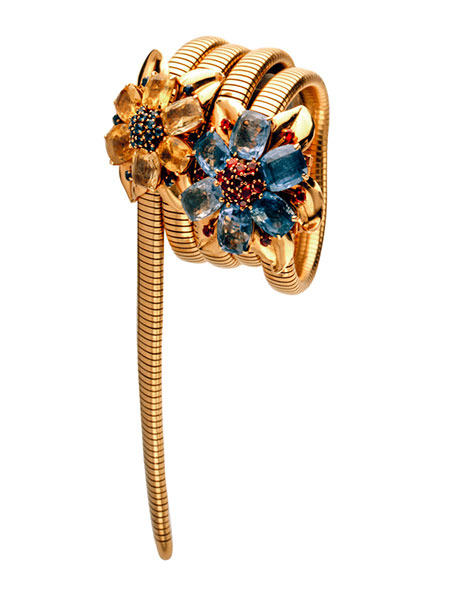 |
| Passe-Partout necklace, Van Cleef & Arpels, 1947. Yellow gold, yellow and blue sapphires, rubies. California Collection. (Photo courtesy Bowers Museum) |
Van Cleef & Arpels’s techniques were so innovative that they were patented, as was the Passe-Partout, pictured above, in 1938. This was a signature piece for the Maison in the late 1930s and 1940s. The jeweled blossoms mask a system of metal rails that allow the snake chain to slide in and out. Above, the piece is coiled as a bracelet, but it can be lengthened to serve as necklace, choker, opera-length necklace, bracelet, or belt. The flower clips can be worn by themselves, or as earrings. In 1951, the Maison created its Zip necklace, inspired by the closure system used in aviator jackets and sailor uniforms. The design was suggested years earlier, in 1938, by the Duchess of Windsor.
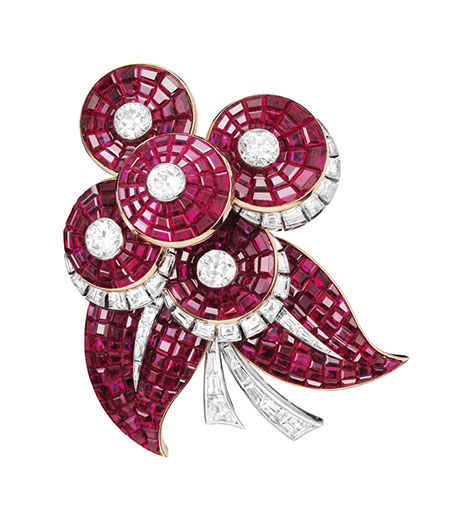 |
| Pastilles clip, Van Cleef & Arpels, 1951. Platinum, yellow gold, osmior, rubies, diamonds. Van Cleef & Arpels Collection. (Photo courtesy Bowers Museum) |
The Pastilles clip pictured above is a superb example of Van Cleef & Arpels’s “Mystery Setting” method, which the jewelers patented in 1933. “The secret behind the Mystery Setting technique,” according to a press release, ”is a delicate lattice of gold ‘threads’ on which the stones—selected to very strict criteria—are positioned one by one to fit precisely into where they will be placed.” The method is extremely time consuming, taking hundreds or thousands of hours to craft a single piece.
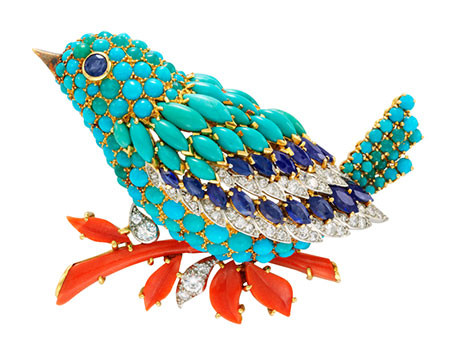 |
| Bluebird clip, Van Cleef & Arpels, 1963. Platinum, yellow gold, sapphires, turquoises, coral, diamonds. Van Cleef & Arpels Collection. (Photo courtesy Bowers Museum) |
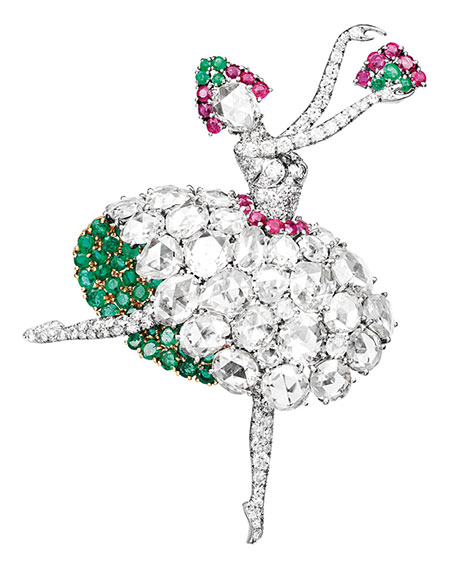 |
| Spanish Dancer clip, Van Cleef & Arpels, 1941. Platinum, yellow gold, rubies, emeralds, diamonds. Van Cleef & Arpels Collection. (Photo courtesy Bowers Museum) |
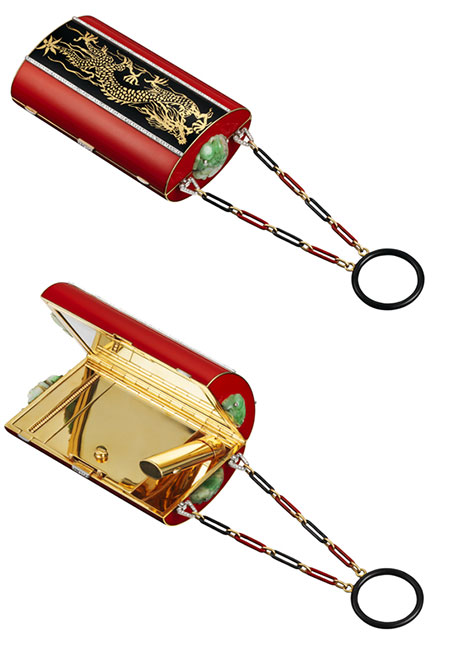 |
| Dragon vanity case, above, Van Cleef & Arpels, 1923. Yellow gold, platinum, enamels, jade, diamonds. Van Cleef & Arpels Collection. The cylindrical red enamel case is set with an enamel band with a gold dragon motif and rose-cut diamond border, opening to reveal four compartments, one with mirror and aide-mémoire cover with slide in pencil, a lipstick, a powder compartment and a vested case. The terminals are decorated with carved jade and diamonds details. A black and red enamel ring was used for handing. The vanity case is mounted in yellow gold and platinum. Dragon clip, below, Van Cleef & Arpels, 1969. Yellow gold, coral, emeralds. Van Cleef & Arpels Collection. (Photos courtesy Bowers Museum) |
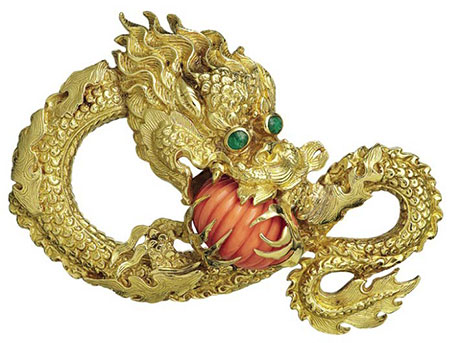 |
Jewels by JAR
Metropolitan Museum of Art, New York,
Nov. 20, 2013 – Mar. 9, 2014
For thirty-five years, Joel A. Rosenthal, who works under the name JAR, has been offering jeweled creations on Paris’s Place Vendôme. He may be best known for his pavé technique, in setting small stones very tightly (using a dark metal alloy), in seamless carpets of stationary, undulating shapes, or articulated, dynamic forms.
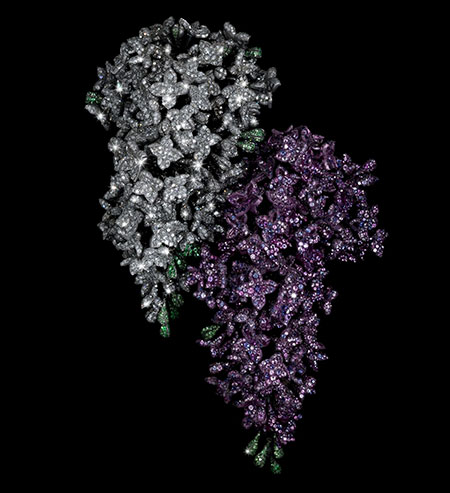 |
| Lilac Brooches, JAR, 2001. Diamonds, lilac sapphires, garnets, aluminum, silver, and gold. Private collection. (Photo: Jozsef Tari, courtesy of JAR, Paris) |
According to a 2006 profile in Forbes, upon moving to Paris after graduating from Harvard in 1966, Rosenthal tried his hand at scriptwriting and then needlepoint. His first storefront was not devoted to jewelry but to “unusually colored yarn,” which attracted designers like Hermès and Valentino. His entry into gemstone designing came in the form of a request, not a personal whim. He then worked at Bulgari in New York as a salesman before returning to Paris in 1977 and designing on his own.
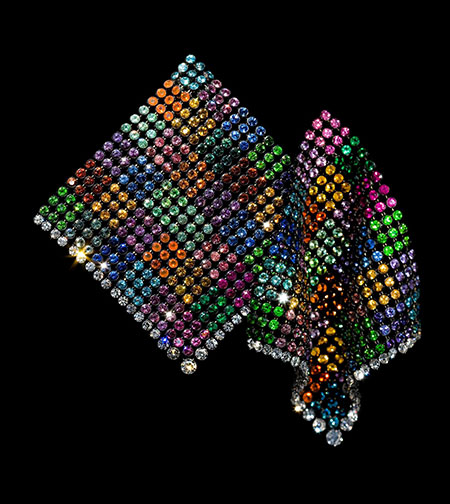 |
| Multicolored Handkerchief Earrings, JAR, 2011. Sapphires, demantoid and other garnets, zircons, tourmalines, emeralds, rubies, fire opals, spinels, beryls, diamonds, platinum, silver, and gold. Private collection. (Photo: Jozsef Tari, courtesy of JAR, Paris) |
For the first time in its history, The Metropolitan Museum of Art is devoting an exhibition to a contemporary gemstone artist, with “Jewels by JAR.” It also is the first JAR retrospective in the U.S.; only Somerset House in London mounted a major exhibition of Rosenthal’s work, in 2002. (That show’s lighting was dimmed, the visitors being given flashlights, according to Forbes.) This show, which opens on November 20, will feature more than four hundred works. The exhibition is accompanied by an affordable, slip-cased catalog featuring 69 images from the show. A pricier monograph, in two volumes, also is available.
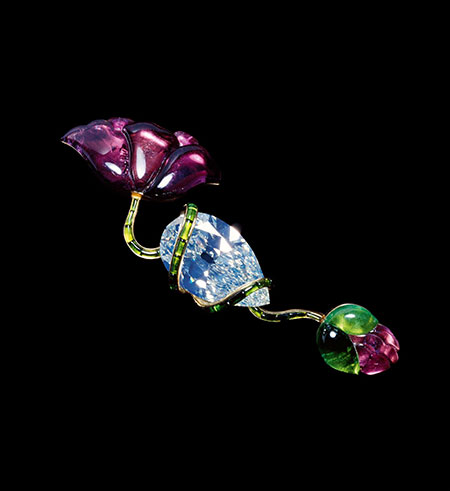 |
| Poppy Brooch, JAR, 1982. Diamond, tourmalines, and gold. Private collection. (Photo: Katharina Faerber, courtesy of JAR, Paris) |
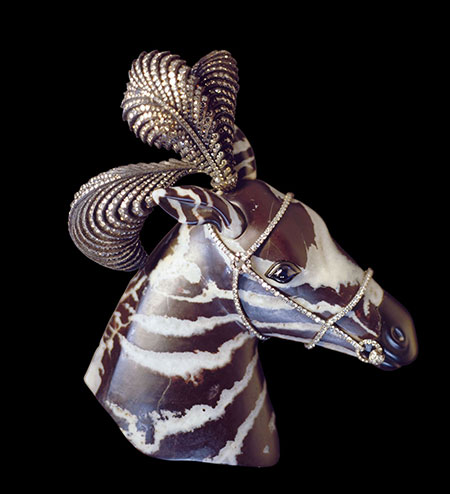 |
| Zebra Brooch, JAR, 1987. Agate, diamonds, a sapphire, silver, and gold. Private collection. (Photo: Katharina Faerber, courtesy of JAR, Paris) |
[back to top]
Changsha: Let a Thousand Museums Bloom
Extensive coverage from Peter Megaw and Allison Megaw
in Rocks & Minerals
The policy of letting a hundred flowers bloom and a hundred schools of thought contend is designed to promote the flourishing of the arts and the progress of science….
—Mao Zedong, On the Current Handling of
Contradictions Among the People, 1957
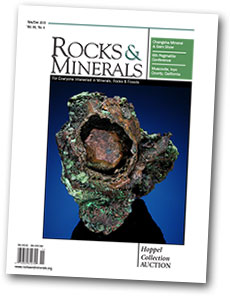 |
Dr. Peter Megaw and Allison Megaw traveled to Hunan Province in May for the First China (Changsha) Mineral and Gem Show (CMGS), not as visitors, but as guests to advise the show organizers on their exhibits. In addition to being a geologist, mineral collector, and author, Peter has long been exhibits chair for the Tucson Gem and Mineral Show™. As the Megaws write in the November–December 2013 edition of Rocks & Minerals (88:6, 502–515; abstract here), “we headed over to what was being billed as the ‘Oriental Tucson Show’ to see whether it was possible to build a Tucson- or Munich-scale show essentially overnight.” The show was held May 15 through May 20.
Changsha, in the northeastern part of eastern China’s Hunan province, may not have been a destination for many of our readers, but you might already have visited it in a virtual sense: as the authors point out, “the bizarre rock pillars” of the nearby Zhangjiajie National Forest Park were inspiration for some of the scenery in James Cameron’s 2009 blockbuster film, Avatar. If you saw the film in 3-D, you felt like you were there, but your other senses were grateful for the omission of Changsha’s 30+°C temperature and 75% humidity. While Changsha was foreign to the Megaws, who hadn’t yet visited China, it also was familiar in the sense of being yet another big city. Adding to the familiarity, at the show, was the fact that that the international dealers, with their well-known faces, were positioned at the CMGS first-floor entrance.
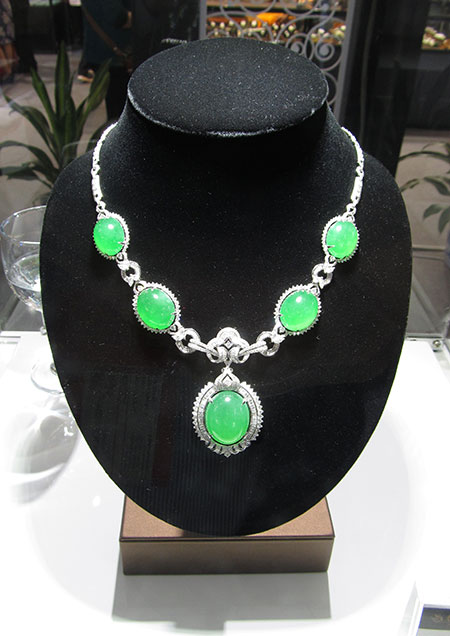 |
| Imperial jade and diamond necklace for sale on the Jewelry and Gemstone Exhibition level. The jade is from Hpakan Kachin State, Myanmar (Burma). Dealer stock. (Photo: Peter Megaw) |
Set-up, as recounted by Pala International’s Will Larson (“Chowing Down in Changsha”), was hampered by merchandise trickling ever so slowly through customs. The Megaws include a photo in their article of Wayne Leicht and Lois Nelson in front of their completely empty Kristalle–Crystal Classics booth on set-up day. Nerves were somewhat eased that evening by the welcoming banquet, although a dish labeled “bacteria chicken” might have given one pause.
The theme of this year’s inaugural show was “Mineral Museums,” and the authors note that this was not an ethereal conceit that evaporated on May 21: over the next ten years, the Chinese government is putting its organizational and financial weight behind more than a thousand new natural science museums focused on geology-mineralogy and fossils. (Okay, collectors, start dusting off your seconds!) Many representatives of world-class museums were in attendance, and when they weren’t involved in the forums they might have been turning a shade of tsavorite, envious of what a government giveaway might do.
 |
| Carving of Buddha made from a single quartz crystal, 120 cm tall. Dealer stock. (Photo: Peter Megaw) |
The authors continue by discussing the nature of the CMGS conference presentations and posters, and the exhibition itself, in some helpful detail. They also provide a lengthy critique of the show, including the differences between Chinese collecting practices and those of the West, and how they foresee a different sort of show in 2014, not only because its theme will be “Mining.” Although their article is slanted towards the mineral specimen collector, anyone interested in the burgeoning China market for minerals and gems would benefit from the information—both textual and visual. Back issues are available at Rocks & Minerals. [back to top]
Pala International News
Pala’s Featured Stone: Danburite from Tanzania
This month we feature not only a rare gem variety but also a gorgeous jewel. Danburite is not usually a gem that causes too much excitement, but this 51.29-carat screamer would catch the eye of any passerby. Reminiscent of a fine golden sapphire or an exotic Malawi yellow tourmaline, this danburite is sure to puzzle the gem connoisseur.
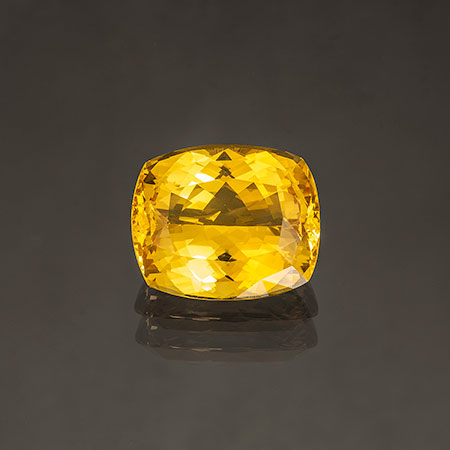 |
| Golden Danburite from Tanzania, 51.29 carats. Danburite is a crystalline mineral similar to topaz. Its chemical formula is CaB2(SiO4)2. It has a Mohs hardness of 7 to 7.5, so it’s very wearable. Ask for Inventory #21490. (Photo: Mia Dixon) |
Danburite is a silicate mineral found scattered throughout the planet in unassuming colors from pale yellow to brown. However, Tanzania is producing these neon yellow hues—color schemes completely unique to danburite. This intense golden yellow danburite comes to us from the Morogoro region in the Uluguru Mountains.
Interested? Call (phone numbers below) or email us to inquire. [back to top]
Gems and Gemology News
GGTL Laboratories Report on Synthetic Diamonds
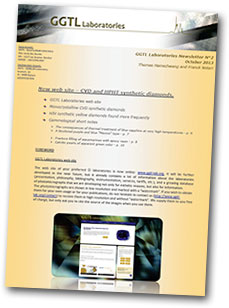 |
In June we pointed to collections of photomicrographs of gemstone inclusions housed on the website of GGTL Laboratories (the merged enterprise of Franck Notari’s GemTechLab and Thomas Hainschwang’s GEMLAB [Liechtenstein]). The lab has issued two newsletters that may be of interest to our readers.
The September 2013 edition consists of a study entitled, “HIH: Multi-treated HPHT-grown synthetic diamonds showing some characteristics of natural diamonds.” The report comes after the lab detected yellow synthetics in parcels of natural melee diamonds. The synthetics had been treated with irradiation and HPHT—after having been grown via the HPHT (high pressure, high temperature) method.
The October 2013 edition of the newsletter discusses a diamond, represented as a CVD (chemical vapor deposition) synthetic, which turned out to be natural. Also discussed are very high temperature heat treatment of blue sapphire, a bicolored purple and blue “Maxixe” beryl, fissure filling of aquamarine with epoxy resin, and calcitic pearls.
Related Industry News
Item: Last week, we received an email from the Diamond Manufacturers and Importers Association of America appealing for a conclave to discuss the matter of synthetic diamonds being represented as natural.
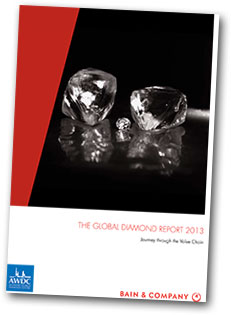 |
Item: Bain & Company, in association with the Antwerp World Diamond Centre, has issued its “The Global Diamond Report 2013: Journey through the Value Chain,” which traces the diamonds’ route to market, “offering for the first time a detailed view of channels and approaches for rough- and polished-diamond sales.” Highlights:
- A balanced market for the next four years; beyond that, a growing gap between supply and demand
- Mining companies will use this time to upgrade, preparing for the future
- The middle market, which earns as little as 1–2%, will continue to consolidate and integrate
- Retailers will want to capitalize on the growing demand, but supply will be a challenge; one solution: investing in the source
[back to top]
Industry News
“Pink Dream” No Sleeper
Sotheby’s sale sets more—and more—records
Long before Sotheby’s Geneva’s Magnificent Jewels sale was held on November 13, the auction house was touting the sale’s centerpiece, the Pink Star Diamond, as “the most valuable diamond ever to be offered at auction.” Indeed, the stone fetched $83.2 million, or $23 million more than the pre-sale estimate of $60 million, setting a world auction record for a diamond or jewel, in a sale that itself set the record for the highest jewelry sale total in history, at $199.5 million.
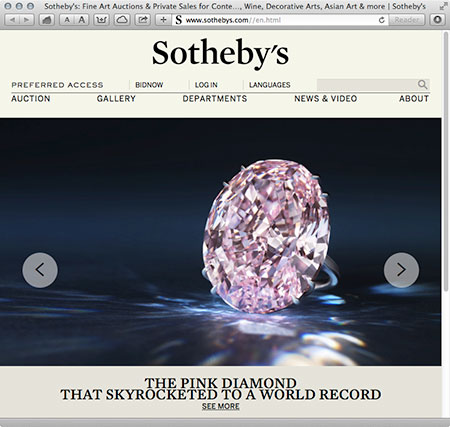 |
The Pink Star was purchased by diamond cutter Isaac Wolf, who renamed it “The Pink Dream.” It was cut from a 132.5-carat rough, mined by De Beers in Africa in 1999, and polished over a period of two years by Steinmetz Diamonds. The jewel was described as a 59.6-carat Internally Flawless Fancy Vivid Pink Diamond. It is the largest such diamond ever graded by GIA, which issued it a Type IIa classification. David Bennett, Chair of Sotheby’s Jewellery Division in Europe and the Middle East and Chair of Sotheby’s Switzerland, stated that the diamond’s size and color surpass diamonds in any known collection—State, Royal or private. It is more than twice the size of the 24.78-carat “Graff Pink,” which set a world auction record for a gemstone, at $46.2 million, in 2010.
And the records kept on coming: a record for a pair of colorless diamond, at $9.2 million, and three more, pictured below.
 |
| The “Walska Briolette Diamond” also set an auction record for a jewel by Van Cleef & Arpels. The diamond weighs in at 96.62 carats and fetched $10.6 million in last week’s sale. It once was in the collection of opera singer Ganna Walska (1887–1984), whose questionable talent put her in the same league as Florence Foster Jenkins, Mrs. Miller, and Wing. (Sotheby’s press image) |
 |
| This Burmese “royal blue” sapphire, weighing 114.74 carats, nearly quadrupled its pre-sale low estimate, selling for $7.1 million—a world auction record for a Burmese sapphire. Below, The Richelieu Sapphires hail from descendants of the family of Cardinal de Richelieu, Louis XIII’s chief minister, and a patron of the arts. This pair set auction records for sapphire jewels, a Kashmir sapphire, and price per carat for a sapphire, selling for $8.3 million. (Sotheby’s press images) |
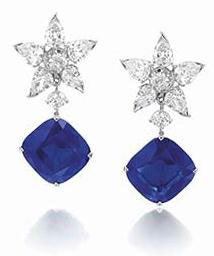 |
[back to top]
The Big Orange
Christie’s sets its own, modest records
The day before the Sotheby’s sale, Christie’s Geneva offered its own colored diamond of a different hue. Dubbed simply “The Orange,” the largest Fancy Vivid Orange diamond ever to appear at auction. It weighs 14.82 carats and had a pre-sale estimate of $17–20 million. The stone achieved about twice that—$35.5 million—setting a world auction record for per-carat price for any diamond and, of course, any orange diamond.
 |
| The Orange. In his 1882 classic, The Great Diamonds of the World, Edwin Streeter called this variety “Fire diamond.” GIA compared it favorably with the finest Sri Lankan sapphire. (Christie’s press image) |
The Christie’s sale set another record for the highest total ever for a Geneva jewelry auction, at $125.3 million. That record was broken the next day by Sotheby’s, at nearly $200 million.
Some exceptional jewels in the Christie’s sale might have shown more brightly if not overshadowed by the record-setting of Sotheby’s. Take for instance a piece by designer-to-the-stars Anna Hu. Her “Côte d’Azur” brooch features a 58.29-carat natural Burma sapphire, its heft balanced beautifully by a “pavé-set diamond floral branch decorated with moonstones, coloured sapphires, tsavorites, tourmalines, spinel, coloured diamonds, carved sapphires, carved and drop-shaped emeralds,” to quote the lot description. With a hammer price of $4.5 million, it set a world auction record both for per-carat price ($78,400) for a Burma sapphire and for a contemporary designer.
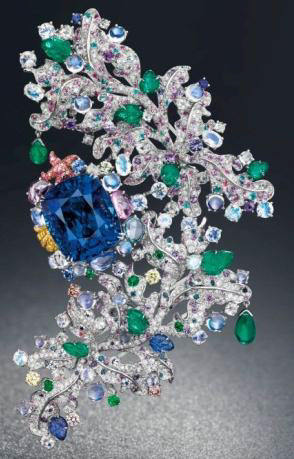 |
| The Côte d’Azur brooch by Anna Hu. (Christie’s press image) |
Another standout from the Christie’s sale echoed Hu’s employment of drop-shaped emeralds: an Art Deco emerald and diamond necklace by Van Cleef & Arpels. It formerly was in the collection of Princess Faiza of Egypt, daughter of King Fouad I. The press release describes it well:
The emerald drops hang from the diamond motives set in such a unique way, that it allows the stones to move very gently on the ‘décolleté’ of the woman who wears the piece. In a very pure Art Deco style, the necklace is imposing, yet graceful, which is normal as it was worn by Princess Faiza as a ‘Court Jewel.’
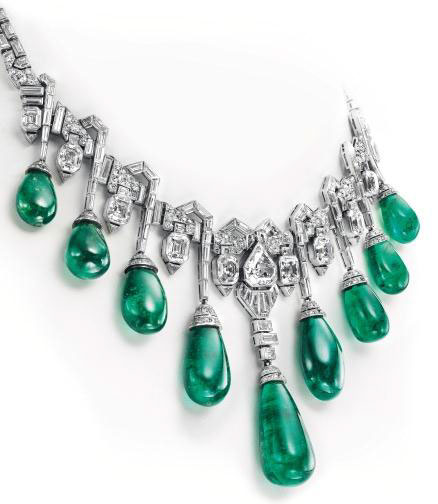 |
| Regal. Following Egypt’s 1952 revolution and the royal family’s exile, many of their jewels were sold and removed from their settings. Surely the gorgeous design of this necklace saved it. (Christie’s press image) |
[back to top]
Burma Bits
Burma to receive 250-year-old fax
In April we noted the 2007 discovery of a “letter” fashioned from gold and cabochon rubies, encased in an elephant tusk, originally sent in 1756 from Burma’s King Alaungpaya to Britain’s George II. George couldn’t read it and had it sent to his hometown library in Hanover, Germany, where it languished for 250 years. There was talk last fall that a facsimile of the letter would be given to Burma, and today this was confirmed by a story in the Myanmar Times (MT).
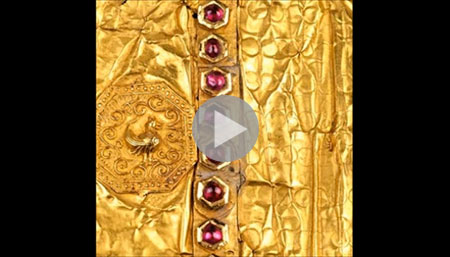 |
| Lost in translation. See a two-minute streaming video providing background about the gold-leaf letter. You may have to read between the lines a bit… |
U Soe Nwe, Burma’s ambassador to Germany, told MT that the facsimile will be given next year for display at Burma’s National Museum, currently under construction. He said that the original will remain in Germany because it was a gift. (It also may have been a bribe of sorts; Alaungpaya was asking for military assistance.)
2014 marks the 60th anniversary of diplomatic relations between Germany and Burma. (Diplomacy in 1756 seems to have suffered, in this case, even though the letter served as Alaungpaya’s permission for the East India Company to build a fortified base on Burma’s coast.) The 60th anniversary will be marked by bilateral cultural and educational activities as well as the opening of a branch of the Goethe-Institut, Germany’s cultural institution. Burma hasn’t had a Goethe-Institut since 1965.
AmCham opens for business in Burma
On Halloween, the American Chamber of Commerce (AmCham) did a little trick-or-treating by opening its Burma chapter in Yangon, as reported by Eleven Media Group. Compared with other western countries, the U.S. investment in Burma remains low. Importation from Burma of all products is now allowed, with the exception of rubies and jade.
 |
| No turkey. This 9.17-carat natural spinel from Burma is just asking to be gobbled up. Inventory #20438. (Photo: Mia Dixon) |
[back to top]
Pala Presents
With Pala Presents, we offer selections from the collection of Pala International’s Bill Larson, who will share with us some of the wealth of information in the realm of gems and gemology.
Chocolate and Chicory: French Gemstone Collecting Cards
In the second half of the nineteenth century, French chocolatier Victor-Auguste Poulain brought his product out of the pharmacy and into the hands of children. Predecessor chocolatiers like Menier had produced the stuff as a medicinal powder. Poulain employed myriad marketing devices, including collecting cards. This month, with Pala Presents we offer five examples of these cards, from chocolatiers Poulin and Compagnie Coloniale as well as chicory vendor C. Beriot. See the full array here.
 |
| Lapidary, 1540. This card appears to be from a series of at least 46 professions and businesses, mostly unrelated to gemstones. The cards were issued for chocolate produced by Compagnie Coloniale, the oldest French tea brand, founded in 1848. Empires may since have fallen, but the Compagnie still thrives. (Image from the collection of Bill Larson) |
[back to top]
— End November Newsletter • Published 11/18/13 —
October 2013 Newsletter
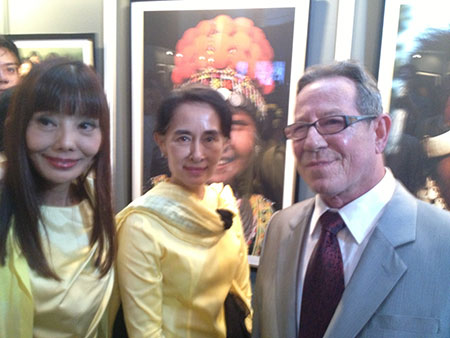 |
| Photo op. Pala International’s Bill Larson snapped this photo of Daw Aung San Suu Kyi after meeting her at the reception for photographer Richard Diran, right. Diran’s exhibition “The Vanishing Tribes of Burma,” was held September 28–30 in Yangon. For more on Bill’s trip to Burma, including Mogok, scroll down. |
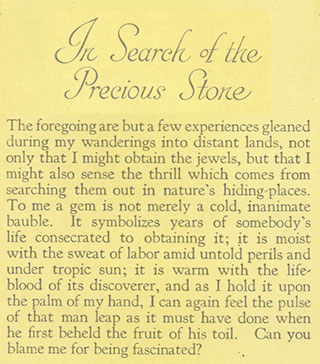 |
| The thrill. This month we feature a reprint of Albert Ramsay’s In Search of the Precious Stone, from which comes the closing quotation above—one of Bill Larson’s, favorites, which speaks to why he too loves gemstones and gemstone mining. |
Shows and Events
- Mineralientage München 50th Munich Mineral Show October 25–27, 2013
- Show-goers Pitch In in Boulder
- MIM’s the Word
Pala International News
Gems and Gemology News
- More on Synthetic Alexandrite and Chrysoberyl
- Cool Story: Chamonix Gemstones
- Temple Treasure: Two Steps Forward, One Step Back
Industry News
Pala Presents
- In Search of the Precious Stone
A reprint of the book by Albert Ramsay
Recycle Bin
Shows and Events
Mineralientage München 50th Munich Mineral Show
October 25–27, 2013
Pala International will be selling and exhibiting
 |
Pala International will be sharing space with Alain Martaud at this year’s Munich Show.
When: October 25–27, 2013
Where: Munich Trade Fair Centre
Hours:
Friday, October 25: 9:00 AM – 7:00 PM (Trade only)
Saturday, October 26: 9:00 AM – 7:00 PM
Sunday, October 27: 9:00 AM – 6:00 PM
Booth: International Mineral Pavilion, Hall A6 Booth 29 (w/ Alain Martaud Minéraux)
This year’s special exhibit—in honor of the show’s jubilee year—is titled “Gold.” It will feature the “Ausrox Gold Nugget” (world’s third biggest, 23.26 kg, 22 x 24 x 16 cm), “Screaming Man” (from Kurnalpi in Western Australia, 20.32 x 7.62 x 5.08 cm), and “Camel” (from Widgiemootha in Western Australia, 7 x 16.5 x10.16 cm). This exhibit will be covered in the Theme Book, a high-quality hardcover, which will include the show catalog. Both publications will be delivered from the show store beginning October 1.
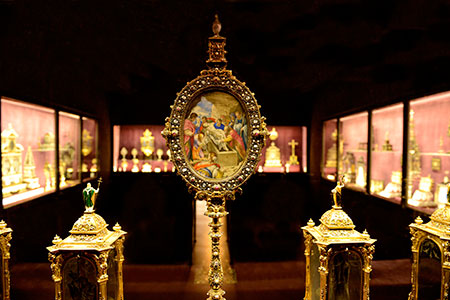 |
| Also featured at this year’s jubilee edition of the Munich Show: “Set in Gold – Precious Stones Within Christianity.” This exhibition offers insight into the chamber of relics held at the Münchner Residenz (Munich Residence, or palace). Above, a reliquary depicts the entombment of Jesus (click to enlarge). Below, a detail of the reliquary, set with gemstones, pearls, and multiple cameos that likely depict Biblical scenes. (Photos courtesy the Munich Show) |
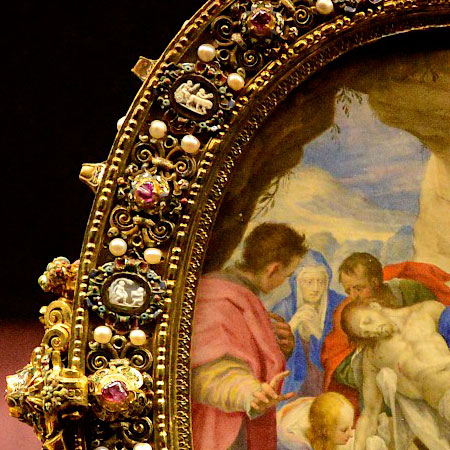 |
As usual, there are many activities for the junior set, such as gemstone faceting, but another activity is available to children of all ages—if you are visually impaired, that is. The “Comprehending Stones” exhibit, presented by Mr. and Mrs. Schwinghammer, is hands-on, “from the edgy surface of a pyrite to the soft texture of a soapstone.”
For more information visit the show website. See the Pala International Show Schedule for future events.
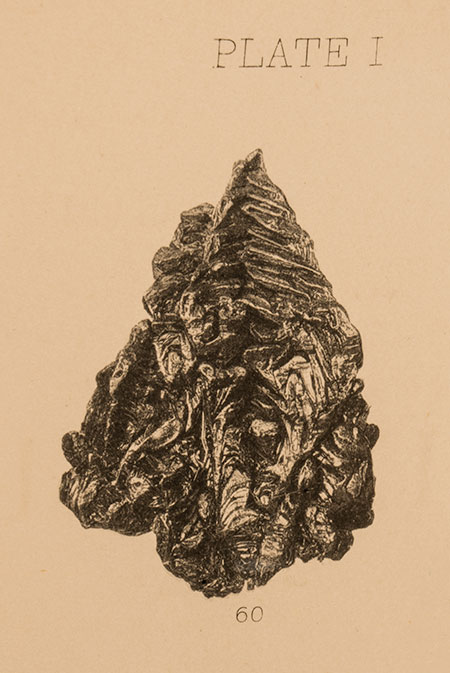 |
| Pala International is proud to exhibit the “Christmas Tree” gold specimen—one of the finest in the world—at the Munich Show’s exhibition, “Gold.” Above, a photographic image of the specimen, created for a sale in 1886. For the history of this fine specimen, see “An Early Christmas at the Munich Show” from our sibling newsletter, Pala Miineralis. (Image courtesy Bill Larson, Pala International) |
[back to top]
Show-goers Pitch In in Boulder
This year’s Denver Gem & Mineral Show took place in Denver just as nearby Boulder County was being pounded by rain. On September 12, the day before the show opened, the area was hit by 9 inches of rain, almost doubling the one-day record of 4.8 inches set in 1919. People in Evans, Milliken and Longmont still are displaced according to yesterday’s Denver Post.
 |
| An aerial view shows flood damage to a road in Colorado, Sept. 16, 2013, due to heavy rains. The speck in the dirt is all that is left of the double yellow line. (U.S. Army photo by Sgt. Jonathan C. Thibault) |
Buried (no pun intended) in a September 22 story was a paragraph that lauded the volunteers—including the Denver Show-goers.
“Now we have to deal with the residue,” said [Boulder homeowner Nick] Krull, upbeat and radiating gratitude for the dozens of volunteers who helped out, including out-of-towners in Boulder for a jewelry convention who ditched the event for cleanup duty.
[back to top]
MIM’s the Word
A new museum opened in Beirut, Lebanon on Saturday: the Museum of Minerals, aka MIM. The museum was conceived by Salim Eddé, Murex software cofounder, and assisted by the Jesuit University. It’s being compared with other world class museums. Read about it here.
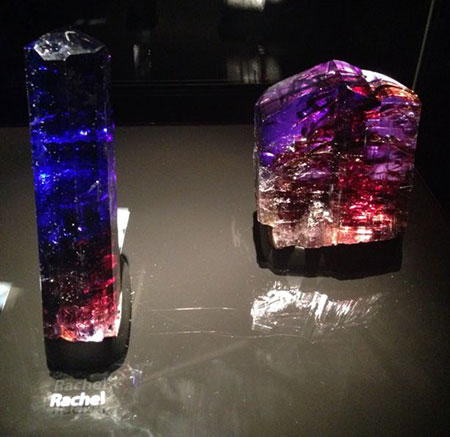 |
| But of course, “Rachel.” These images were sent to us by Dr. Raquel Alonso-Perez, curator of the Mineralogical and Geological Museum at Harvard University. |
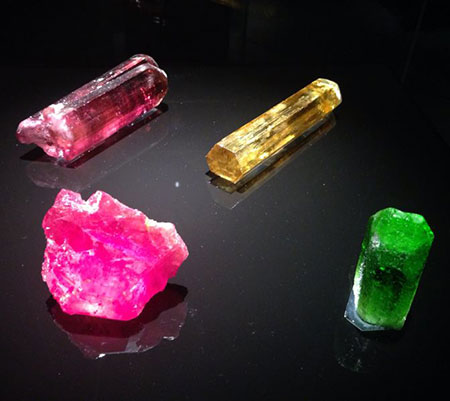 |
[back to top]
Pala International News
Pala’s Featured Stones: New Favorites
In the mind of a gem dealer or gem connoisseur, the favorite gem seems to be the next one. The thrill of unveiling a completely brand new stone is the fuel that keeps us pining for that ideal gem. That rush of the senses as you first lay eyes on a beautiful jewel is like no other. In this way the gem addiction rolls on and keep us wondering, Could there be another one even finer on the horizon? This one in front of me seems to be the finest, rarest, most colorful, but what else could lay in store, just waiting to be plucked from the Earth?
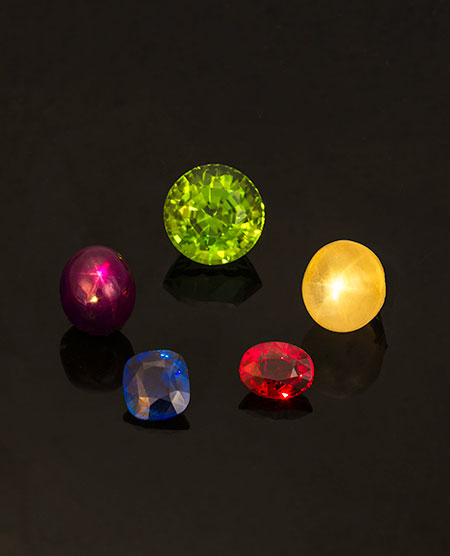 |
| Circle of color. Here we have a 9.57-ct. peridot from Burma, a 11.83-ct. pale yellow star sapphire from Sri Lanka, a 2.53-ct. Mozambique ruby, a 2.03-ct. Madagasy blue sapphire and a 8.88-ct. Sri Lankan puroke star sapphire. Click to enlarge. (Photo: Mia Dixon) |
Being one of the biggest colored-stone houses in the U.S., we at Pala International are very fortunate to have new gemstones presented to us all the time. The mastermind behind Pala (Bill Larson) is even more fortunate to be able to travel the globe in search of the latest gemstones to enter the market. This month we feature a little sampling of Bill’s most recent finds in Thailand and Burma. A delightful array of colorful, exotic, and phenomenal jewels…. Enjoy!
Gems and Gemology News
More on Synthetic Alexandrite and Chrysoberyl
Synthetic alexandrite grown by horizontally oriented crystallization (HOC) in Novosibirsk, Russia
The prolific Dr. Karl Schmetzer has produced two more studies of synthetic alexandrite, published in The Journal of Gemmology (Vol. 33, No. 5–6, 2013).
The first study, “Synthetic alexandrites grown by the HOC method in Russia: internal features related to the growth technique and colorimetric investigation” (pp. 113–129; abstract here), is co-authored with Dr. Heinz-Jürgen Bernhardt, Walter A. Balmer and Thomas Hainschwang. Samples of HOC-grown material have been produced and marketed commercially since the mid-1990s, yet until the present study, no complete gemological description of the material has appeared. This material was developed by Vladimir V. Gurov at the Institute of Geology and Geophysics, Siberian Branch of the USSR Academy of Sciences in Novosibirsk, Russia.
HOC is the acronym for the horizontally oriented crystallization method of growth, but when contrasted with the “vertical floating zone” growth method, which three of the authors wrote on last year, the HOC method could be viewed as the “horizontal floating zone” method. Synthetic alexandrites produced by this method exhibit color-change comparable to natural alexandrites produced in Hematita, Minas Gerais, Brazil, the most productive mine since the 1980s. Typically, this is an intense bluish green to blue green in daylight; in incandescent light it is violet purple or purple.
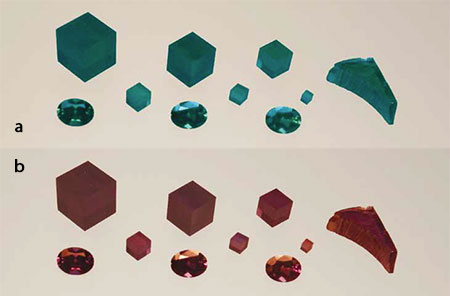 |
| From a large crystal of 39.2 grams in weight not pictured here; the photos, (a) in daylight and (b) in incandescent light, show a slice from the crystal, three faceted alexandrites cut with the table facets exactly perpendicular to either the a-, b- or c-axis of the crystal (weighing 1.63 to 1.75 ct), and six cubes cut with their faces exactly perpendicular to the a-, b- and c-axes of the crystal (weighing 0.17 to 18.05 ct, edges of the cubes 2, 3, 4, 6, 8 and 10 mm). (Photo: K. Schmetzer) |
Interest in material produced for jewelry purposes began in the late 1980s and samples have been grown since the mid-1990s at the Institute of Geology and Mineralogy (part of what was the Institute of Geology and Geophysics) in cooperation with the Tairus company, also in Novosibirsk. The crystallization is facilitated by components that are similar to those developed in the 1970s for the growth of large corundum crystals, and the present study details the production technique in a sidebar.
The researchers were given two samples. Seven faceted alexandrites originally from Tairus in Bangkok also were studied. All were compared against samples grown via the Czochralski method. Rough sample B, from which cut samples pictured above were taken, measured about 38 × 23 mm, thickness 14.5 mm, weight 39.2 g. A boat-shaped molybdenum container is used in the process, and the researchers were given schematic information by the producer that located the two samples in the container. Thus the researchers were able to verify the direction of growth and explain the morphology.
The study expands on only limited information produced heretofore on inclusions in HOC alexandrites. In all the samples were found: curved growth striations and irregularly shaped or elongated cavities.
Chemical properties were compared against those reported by Malsy and Armbruster (2012). Although different methods were used, the results were more or less the same, with—no surprise—chromium being the dominant color-change element, followed by vanadium (at about 75% that of chromium). Distribution between the two was random.
Given the fact that color change is alexandrite’s claim to fame, the study spends nearly a third of its pages on color. The HOC samples, according to the authors, were ideal for colorimetric study due to the paucity of variation in chemical composition within the samples. Color change in alexandrite depends on (a) the direction of observation of a faceted stone or rough relative to its orientation to the a, b and c crystallographic axes; (b) the content of trace elements that cause color change; and (c) the length of the path of light within a sample, relating to thickness (also described as Usambara effect in gemology). Factor (c) is dramatically demonstrated in the figure below. The photos illustrate three different color phenomena, which haven been often mixed erroneously: pleochroism (due to different orientation of samples), alexandrite effect (due to different light sources) and Usambara effect (due to different thickness of samples = path of light within the samples).
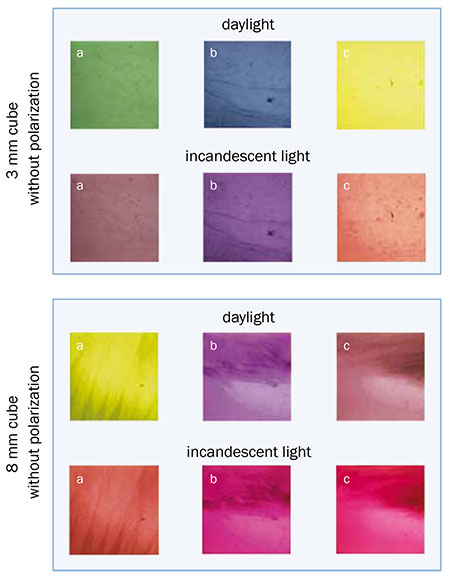 |
| Schematic representation of color and pleochroism in two cubes of HOC synthetic alexandrite with edges of 3mm and 8mm, in daylight and incandescent light; the cube faces are exactly perpendicular to the a-, b- and c-axes of the alexandrite crystal; with the unaided eye (in non-polarized light) different views parallel to the these three axes are depicted. The illustration demonstrates a combination of pleochroism, the alexandrite effect in daylight and incandescent light and the Usambara effect for different path lengths of light. (Photos and artwork: K. Schmetzer) |
Absorption spectra were graphed and discussed as well as results of infrared spectroscopy. In comparing the HOC material with Czochralski-grown synthetic alexandrite, there was no significant difference in infrared spectra. The two also exhibit curved growth striations and gas bubbles, but somewhat differently shaped cavities.
Rarely, one would think, does the laboratory hold material that is so homogeneous as these HOC synthetics. That in itself must have been a little startling...
Titanium-bearing synthetic alexandrite and chrysoberyl
If you were curious about synthetic alexandrite grown by the Czochralski method, mentioned above, Dr. Schmetzer and co-authors Dr. Heinz-Jürgen Bernhardt and Thomas Hainschwang discuss this, and chrysoberyl grown by the same method, in a second article published in the same issue of The Journal of Gemmology, “Titanium-bearing synthetic alexandrite and chrysoberyl” (pp. 137–148; abstract here).
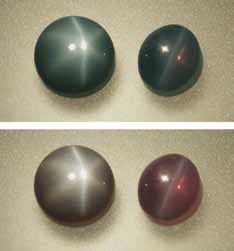 |
| Synthetic asteriated alexandrite (left, 2.62 ct, diameter 8.0 mm) and synthetic alexandrite cat’s-eye (1.55 ct, 7.0 x 6.0 mm) produced by Kyocera in Japan in daylight (above) and incandescent light. (Photo: K. Schmetzer) |
In the late 1980s, synthetic alexandrite cat’s-eyes produced by the Japanese firm of Kyocera emerged on the market under the trade names “Inamori synthetic alexandrite” and “Inamori created alexandrite.” This synthetic material, when cut as a cabochon in a particular direction, usually exhibited a well-centered cat’s eye light band. In 1987, R. E. Kane reported (Gems & Gemology, 23:3, 158–62) that, under a strong, single incandescent light down the long direction, asterism could be seen. As shown at right, a cabochon can display asterism when cut with its base perpendicular to that producing a cat’s eye.
In their 2011 study of synthetic star alexandrite (Gems & Jewellery, 20:3, 9–11), Dr. Schmetzer and Alan Hodgkinson found that the studied stones, when examined microscopically in immersion, did not show exactly the same pleochroism that earlier had been seen in synthetic vanadium- and chromium-bearing alexandrite. Preliminary spectroscopic examination also showed differences to the absorption spectra that were expected for such chromium- and vanadium-bearing, iron-free samples of synthetic material, which had higher chromium than vanadium contents.
The search was on for another color-causing trace element, but the data showed only chromium, vanadium and titanium. The latter was thought to occur in the form of rutile precipitates, which cause asterism and/or chatoyancy.
A review of the relevant patent literature shows different production techniques for synthetic alexandrite cat’s-eyes. One of these techniques for the production of alexandrite cat’s-eyes involves a two-step growth and annealing process. The first step includes the production of homogeneous single crystals containing titanium oxide as dopant. It is claimed that such specifically-doped crystals can be grown by any known technique suitable for the crystal growth of chrysoberyl, but the floating zone method is described in detail. Crystal growth is performed under argon, nitrogen or hydrogen atmospheres and titanium is present in its trivalent state. In the second step, annealing of the crystal at elevated temperatures in an oxidizing atmosphere is performed. During this second part of the process titanium is oxidized and elongated particles, most probably rutile needles, are precipitated. These exsolved particles are responsible for the chatoyant effect of the material when cut as a cabochon.
A process assigned to Kyocera Corporation describes the production of chrysoberyl cat’s-eyes with a similar first step growth process using a specific dopant. In contrast, a subsequent heat treatment step is not directly mentioned.
The present study discusses the role of trivalent titanium (Ti3+) in synthetic crystal materials. This contrasts with natural material; in most rocks and minerals titanium occurs only as Ti4+, with trivalent titanium being unstable. The study continues, investigating the role of Ti in the Kyocera chrysoberyls and alexandrites, irrespective of their asterism or chatoyancy.
The samples studied were (a) reddish-violet chrysoberyl rough-cut crystals and faceted stones (without particular orientation) from Kyocera Germany, evidently originally from rough Czochralski-grown crystals; (b) alexandrites from Kyocera, both rough-cut crystals and faceted stones; and (c) alexandrite cat’s eyes and stars prepared by A. Hodgkinson from a synthetic crystal originally purchased in 1988, with two samples displaying 6-rayed stars and one displaying a cat’s eye. Also in (c) were two more cat’s eyes from George Bosshart’s private collection.
The researchers performed chemical analysis, absorption spectroscopy, examined growth striations, chatoyancy/asterism and pleochroism, all of which is documented in the detail for which Dr. Schmetzer and his colleagues are known.
The main results of the study show that titanium is present in synthetic alexandrites cat’s-eyes and asteriated alexandrite of Kyocera Corporation in two valence states. Needle-like precipitates, most probably rutile needles with titanium in its tetravalent state, are present in three different directions. According to the orientation of the cabochons, six-rayed asterism or chatoyancy is observed.
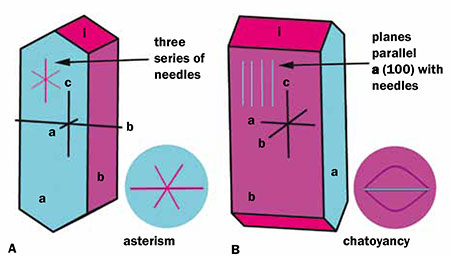 |
| Schematic drawings of asteriated or chatoyant synthetic alexandrite crystals in views parallel to the a-axis (A) and parallel to the b-axis (B). The light effect is due to three series of needles which are all located in planes parallel to the a (100) pinacoid; the orientations of the needles are parallel to the c-axis and the two i (011) faces. In a view parallel to the a-axis (A) the orientations of the needles reflect light to form a regular six-rayed star; in a view parallel to the b-axis (B), only one strong light band is seen in the centre of the chatoyant cabochon. (Diagrams: K. Schmetzer) |
The color of the samples is due to a combination of chromium, vanadium, and titanium, with titanium present in its trivalent state. This is similar to some Kashan synthetic rubies, in which titanium (in addition to chromium as main colour causing trace element) is also present in its trivalent state.
We look forward to the next studies coming from the laboratory bench of Dr. Schmetzer and his colleagues. [back to top]
Cool Story: Chamonix Gemstones
Collectors of mineral specimens will recognize the locality of Chamonix as producing lovely fluorite and smoky quartz. But on September 9, Chamonix (located where France touches both Switzerland and Italy) produced as much as €246,000 worth of rubies, sapphires and emeralds.
According to reports by CNN and Planetmountain.com, a young climber ascending the Bossons glacier (on the southeastern side of the Chamonix valley) came upon a metal box in the snow. Such a sight is common in a glacier, which regularly regurgitates anything left on its face. For this alpinist the box was anything but common: it held several bags stamped “Made in India” containing the aforementioned gemstones. The anonymous climber turned the cache in to police in Bourg-Saint-Maurice on September 9.
 |
| “Way up—way down”: the title below this undated illustration of Die calotte des Mont Blanc nebst der Mur de la Côte und den zunächst liegenden Eismassen in der Morgenalpengluht (“The cap of Mont Blanc together with the Mur de la Côte, and the first ice lying in the morning alpen glow”). The Mur de la Côte is the slope wall pictured directly below the glowing cap. Click to enlarge. (Image courtesy Library of Congress, by C. Ullrich after a sketch by Dr. W. Pitschner) |
Police now are charged with determining the gems’ ownership. The task is facilitated, however, by the fact that the stones likely came from one of two airplane crashes that were recorded in the area in the last century. In 1950, Air India charter Flight 245, the “Malabar Princess,” crashed into Mont Blanc, situated above the glacier, killing all 48 passengers and crew. The plane’s destination? A stop in Geneva, between Mumbai and London. The second crash occurred in 1966. Air India Flight 101 was bound from Mumbai to New York. If this was the plane that carried the precious cargo found last month, one among its 106 passengers was precious enough himself to warrant a raised eyebrow. Killed in the crash was Homi Jehangir Bhabha, known as “father of India’s nuclear program,” and news of his death was received with an obligatory conspiracy theory: surely the CIA had engineered Bhabha’s death in order to cripple India’s nuclear weapons program. As we know, the program hardly was crippled. A year-long investigation into the crash cited human error on the part of the pilot-in-command.
 |
| Parts of aircraft and even human remains regularly make their way towards the Chamonix valley floor, as shown in this brief streaming video. |
The Guardian reported last month that Flight 101 more likely had the jewels on board. Indeed, according to a January 25, 1966, UPI story, among the passengers was the Belgian “Baroness Degiey.” Details regarding the passengers of Flight 245 were not reported in the American press, but an overview of that flight by documentarian Georges H. Morel states that the passengers consisted of forty soldiers of the Indian navy and eight crew members, not likely to have had what was then $45,000 worth of gems in their duffel bag. [back to top]
Temple Treasure: Two Steps Forward, One Step Back
It’s been over a year since we looked at progress at Shree Padmanabhaswamy Temple, the treasure vaults of which have been inventoried for the last two years. Quite a stir was caused when the temple’s riches came to light through a legal battle that began in 2007, as we noted in July 2011.
The most recent reports, from this past July, were from a leaked document, dated May 30, claiming the temple’s administrative officer “had made many lapses earlier in maintaining the temple properties and many allegations of corruption connected with the temple are existing against him,” according to The Hindu. Stewardship of the temple’s treasure was exactly what had caused the late T. P. Sundara Rajan to take the issue before India’s Supreme Court; that court ordered the audit. On August 3, temple management countered the leaked report.
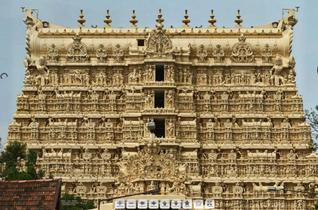 |
| Screenshot of an ambitious 360-degree zoomable “virtual tour” of the Shree Padmanabhaswamy Temple by Kerala photographer Leen Thobias, whose accomplishment was noted by The Hindu. The project required 1,600 high-res images. |
In May, Architecture Professor, Binumol Tom, of the College of Engineering, Thiruvananthapuram, wrote his own plea for careful consideration regarding the temple’s architectural (and spiritual) integrity, in the face of needed renovation.
Details of the gemstones in the temple treasure came out in a Hindu story April 13. The story discussed the seventh interim report on the inventory, including the following.
- The experts conducting the inventory planned to request assistance from the National Geographic Society in order to meet an unspecified deadline
- Of the several hundred thousand objects documented as of mid-March, roughly 500 were studded with gems; most of these contained 100 or more stones—60,000 in all
- Of six underground vaults, “B” had yet to be opened; “A” was being worked on, with 103,000 items documented thus far
- Late Roman coins from the mid-4th century C.E., 14th century Venetian coins, and 14,000 gold-covered votive Arka flowers had been found in the vaults
Last December, the auditors were granted nine more months to complete the inventory, according to The Hindu. An earlier October 25, 2012, story, stating that the inventory would be completed by August 20, 2013, mentioned that the necklaces (sarappollimalas) found in Vault A contained lockets encrusted with rubies, diamonds, emeralds, cat’s eyes, pearls and coral. The story discussed a report that only 30–35 objects could be documented in a day. In Vault A, which holds the most valuable articles, that number was reduced to 2–4 objects per day.
So, what about that August 20 deadline? A Times of India story on September 6 reported that Vault B still had not been opened. [back to top]
Industry News
Burma Bits
Back from Burma
Pala International’s Bill Larson has returned from Burma and has the photos to prove it. When he wasn’t brushing elbows with the likes of Aung San Suu Kyi he was getting those elbows dirty in the mines of Mogok. See it all here.
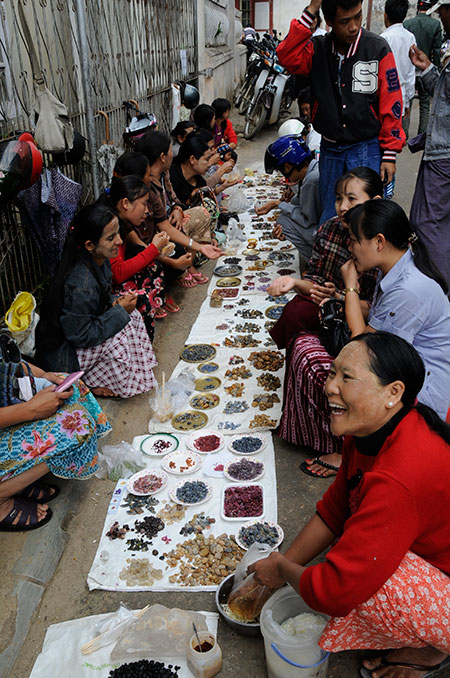 |
| Women’s gem market in downtown Mogok. Negotiating with a dealer, right, who smiles, indicating that she is winning. (Photo: Bill Larson) |
Broken News: EU Scraps Sanctions
This news is a little old, but…. In May of last year we noted that the European Union had agreed to lift sanctions against Burma for twelve months. This year, the EU made the lifting of the sanctions permanent, as reported on April 22 by BBC. Aung San Suu Kyi was quoted as saying that it was time for the sanctions to be lifted.
Bite-Sized Bits
- The Irrawaddy: Burma’s old guard clings to $8 billion jade empire
- The Irrawaddy: World’s most expensive necklace on sale at Singapore jewelry show
- Eleven Media Group: Burma–Thai illegal border trade booming
- Eleven Media Group: Myanmar Gems Entrepreneurs Federation to found public bank
- Eleven Media Group: Burma royals’ jeweled garments to be maintained by Japanese firm
[back to top]
Pala Presents
With Pala Presents, we offer selections from the library of Pala International’s Bill Larson, who will share with us some of the wealth of information in the realm of gems and gemology.
In Search of the Precious Stone
A reprint of the book by Albert Ramsay
This month’s text, In Search of the Precious Stone, was published privately by Albert Ramsay in 1925. Given its illustrations and artful layout, we offer it in facsimile form.
Albert Ramsay is perhaps best remembered for having purchased and then cut the rough Mogok sapphire known as Gem of the Jungle a few years after the present work was written. According to Richard W. Hughes (with U Hla Win, Journal of Gemmology, 24:8, Oct. 1995, 551–561), drawing on contemporary sources, the rough was water-worn, doubly-terminated pyramid that weighed 959 carats. Ramsay acquired it for about £13,000 and cut it into nine stones ranging from 66.53 to 4.39 carats.
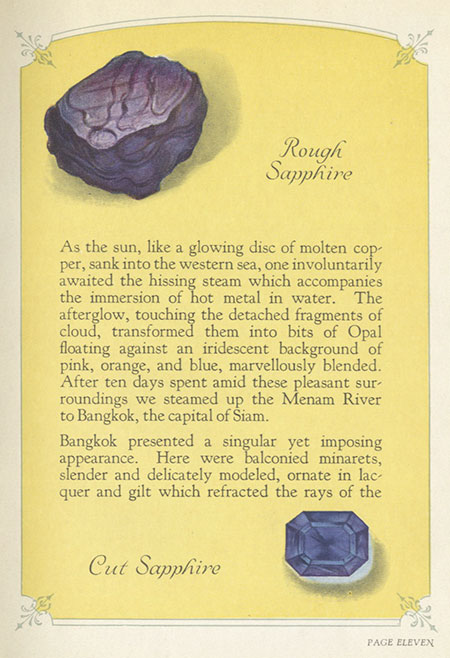 |
| A page from In Search of the Precious Stone, in which Ramsay covers opal, sapphire (including star sapphire), ruby, cat’s eye and emerald. |
[back to top]
Recycle Bin
Below is a recent item from our sibling publication, Pala Mineralis, that will be of interest to colored gemstone enthusiasts.
Iron Stylings from the Sky
Meteorite material finds its way into ancient designs
Turning for a moment from accessories terrestrial, we look at out-of-this-world baubles—from ancient Egypt.
Personal taste and the desirability of a given material varies over time. This is nowhere more evident than in the refined discrimination of ancient Egyptians—those who could afford lapis, carnelian, jasper, quartz crystal, turquoise and malachite. Of course, these were softer and more workable than harder stones; thus even colored glass was employed in Egyptian jewelry designs. But these ancients also held meteorite iron in the same esteem as gold and gemstones, according to authors of a new study.
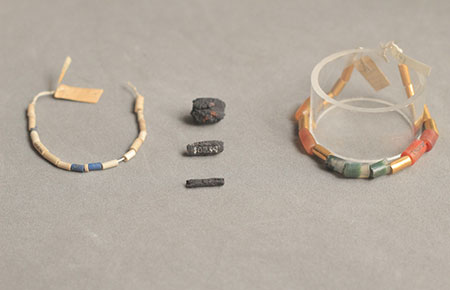 |
| Beaten beads. Meteoric iron beads along with other exotic minerals found in grave 67. The ancient Egyptian iron beads are held at the University College London Petrie Museum. They were hammered from pieces of meteorites, rather than terrestrial iron ore. The objects, which trace their origins to outer space, also predate the emergence of iron smelting by two millennia. Click to enlarge and click to see more images. (Photo courtesy UCL Petrie Museum/Rob Eagle) |
In surviving examples of this ancient jewelry, it’s the proximity the iron beads have to the gemstones that prompted a suggestion of value and worth by the authors of “5,000 years old Egyptian iron beads made from hammered meteoritic iron,” available for public reading from the Journal of Archaeological Science.
The iron material—actually a natural alloy of iron and nickel—was carefully shaped by hammering the metal into thin sheets and then rolling them into tubes, according to the study. As early as the fourth millennium C.E. the artisans already had mastered the smithing of this material, which is more brittle and harder than the copper that was more commonly fashioned. The material’s origin was determined by scanning for trace elements that normally are found in higher concentrations than in terrestrial iron ore.
For more information on meteorites in Egypt, as well as the contribution one made to King Tutankhamen’s necklace, visit the UCL Museums & Collections blog.
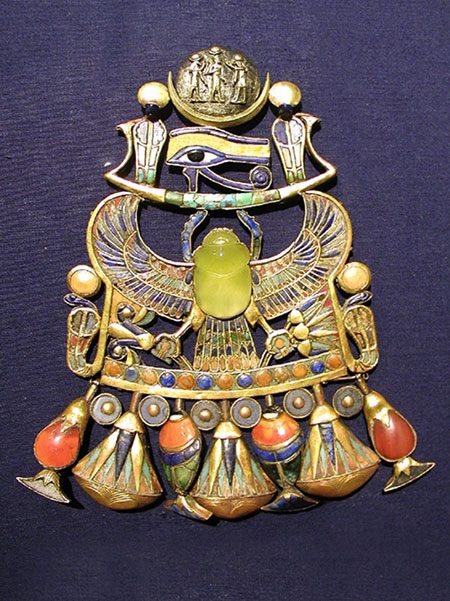 |
| Recycled glass. A new study published in the journal Earth and Planetary Science Letters discusses an odd stone: a remnant of a cometary nucleus fragment. The coment could have formed the “Libyan Desert Glass” scarab that graces the necklace of Tutankhamen’s necklace, above. (Photo: Jon Bodsworth, The Egypt Archive) |
[back to top]
— End October Newsletter • Published 10/15/13 —
September 2013 Newsletter
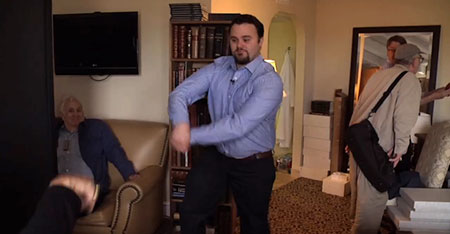 |
| BlueCap Productions has released the What’s Hot In Tucson 2013 two-DVD set. (Click for outtakes.) To receive a 10% discount, just enter the code palaintl when you’re asked for it while ordering. And this news might cause a gem dealer or two to shake a tail feather: Forbes reports that the (Sept. 11–17, 2013) “Hong Kong Jewelry Show May Signal Industry Recovery.” |
Shows and Events
- The Art of Bulgari at the de Young, Sept. 21, 2013 – Feb. 17, 2014
- Pearls at the V&A Museum, Sept. 21, 2013 – Jan. 19, 2014
- Mineralientage München 50th Munich Mineral Show October 25–27, 2013
- Lady Heart Diamond Collection at the NHMLAC, through December 1
- Seine-sational Figures and Events in Gemological History
- Sight and Sound in Denver
- InColor Covers Sinkankas Symposium
Pala International News
Industry News
Books
- “And the low shall be high”
Historian Paul Koudounaris finds jewels in the charnel house
Shows and Events
The Art of Bulgari: La Dolce Vita & Beyond, 1950–1990
de Young Museum, San Francisco, Sept. 21, 2013 – Feb. 17, 2014
In 1985, your editor toured Europe with a fine volunteer choir under the baton of Frank Brownstead, now director of music at the Roman Catholic cathedral in Los Angeles. As I wrote two years ago in our sister publication, Pala Mineralis, we choristers were a little miffed at beginning the tour at the Pius Church in Meggen, Switzerland, just outside Lucerne. We already were crabby from mistakenly opting for a bus with forced-air rather than real A/C, only to arrive for our first concert at what appeared to be an industrial park. Until the hour of our performance we hadn’t understood that the church’s white marble walls (from the same source as the Acropolis) would transmit a gorgeous honey light at sunset. All was forgiven. The next night we time-traveled to the shores of Lake Como, singing in the Chiesa San Giorgio, the Medieval ancestral church of our tour director. I still remember the grand but decrepit fresco on the wall of (I think it was) the church hall, depicting an armored figure with Gothic angularity—perhaps St. George himself. Then we were off to Florence to sing a Mass at the cathedral, Il Duomo.
There was leisure time, too. The dollar was strong, as I recall, else how could we have dined so lavishly at a Florentine ristorante whose patrons were adorned in jewels I’d only seen in magazines? This was the period when Bulgari offered those opulent and, what looked in the ads to be, hefty chokers and necklaces, often incorporating antique coins. The firm itself calls this design element “a sense of volume.” Having been skeptical, I was fascinated to see that what appeared to be unwearable on the page, in life looked dramatic yet dignified on the necks of women dining on piatti of prosciutto e melone and gnocchi al coniglio against stone walls as ancient as the Bulgari family’s inspirations.
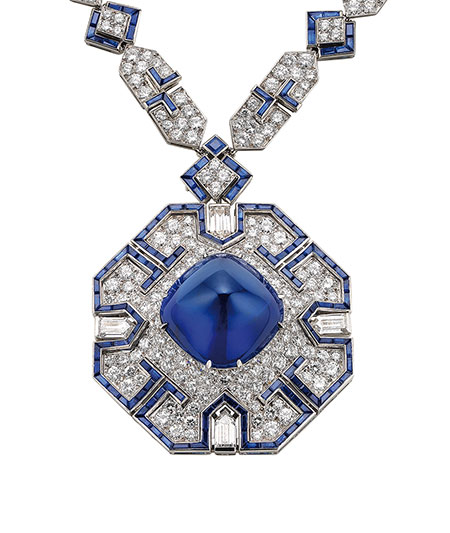 |
| Sautoir, 1969, Platinum with sapphires and diamonds, Chain: 74 x 1 cm. Pendant/brooch: 4.9 x 4.9 cm. Formerly in the collection of Elizabeth Taylor. Bulgari Heritage Collection, inv. 6675 N2170. (Photo © Antonio Barrella Studio Orizzonte courtesy de Young Museum) |
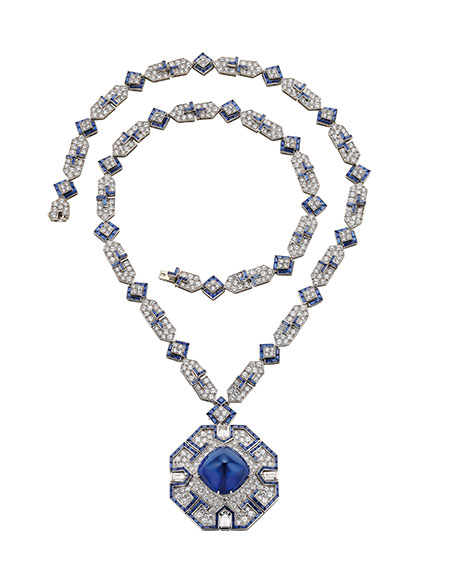 |
This Saturday, visitors to San Francisco’s de Young Museum will have their own chance to view the Bulgari oeuvre of the 1980s, and more, via “The Art of Bulgari: La Dolce Vita & Beyond, 1950–1990.” A museum press release dates the Bulgari “trademark” in design to the 1960s—“by embracing boldly-colored combinations of gemstones, use of heavy gold, and forms derived from Greco-Roman classicism, the Italian Renaissance, and the 19th-century Roman school of goldsmiths.”
The designs on exhibit contributed to the “Italian school,” but there may be some surprises along the way. The release includes a quote from Andy Warhol: “I always visit Bulgari because it is the most important museum of contemporary art.” But, per the press release, Bulgari did its own borrowing from the the world of popular culture. Remember Raquel Welch’s stars-and-stripes (and Stetson) outfit from the film Myra Breckinridge? Martin Chapman, a curator at the Fine Arts Museums of San Francisco sees a link between such pop iconography and Bulgari’s incorporation of Old Glory in a “whole range” of such designs.
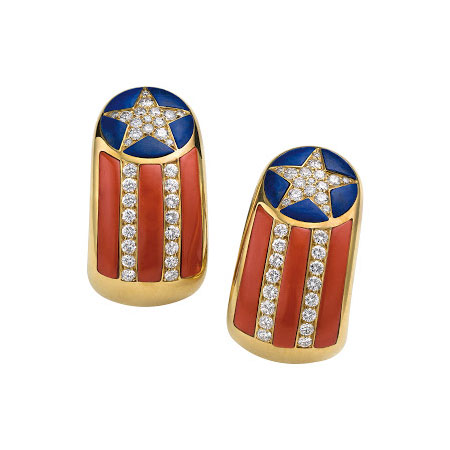 |
| “Star Spangled Banner” earrings, ca. 1975. Gold with coral, lapis lazuli, and diamonds, 3 x 2.3 cm, Bulgari Heritage Collection, inv. 4943 E1063. (Photo © Antonio Barrella Studio Orizzonte courtesy de Young Museum) |
A catalogue of the exhibition is offered by the de Young. “The Art of Bulgari” continues at the de Young through February 17, 2014. Buon divertimento! [back to top]
Pearls
Victoria and Albert Museum, London, Sept. 21, 2013 – Jan. 19, 2014
The V&A and Qatar Museums Authority have teamed up for an exhibition, “Pearls,” which opens this Saturday. The V&A website is not being stingy in its preview of what’s in store, with the exhibition pages filled with teasers to tempt your attendance. What you won’t see represented may lure you in, if you needed it: on display will be a pearl-drop earring worn by Charles I at his 1649 execution, and a necklace of cultured pearls given to Marilyn Monroe by Joe DiMaggio in 1954.
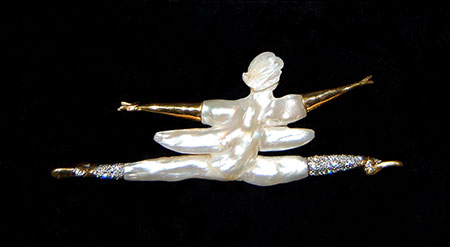 |
| Grand Jeté, gold with diamonds and two cultured baroque pearls. By Geoffrey Rowlandson, London, 1999. (Photo © Geoffrey Rowlandson, courtesy the V&A Museum) |
The significance of pearls has morphed through time. In antiquity, they were indicative of the owner’s rank and wealth. In medieval Europe, they became a symbol of purity and chastity. And “lunar” is the first association Pearl receives in J. C. Cooper’s An Illustrated Encyclopaedia of Traditional Symbols. Both became linked with the Virgin Mary, who is enshrined at the moment of her annunciation in the 14th century Hylle Jewel, included in the exhibition. It is crafted in the form a crowned Lombardic initial “M,” ingeniously utilizing the spaces between the letter’s verticals as Gothic windows framing Mary and the angel Gabriel. The verticals (the window’s mullions) are encrusted with several pearls as well as rubies, emeralds and rough diamonds. The central mullion is decorated with a ruby in the shape of a rather pregnant vase from which springs three lilies—sans stamens, of course—another of Mary’s symbols.
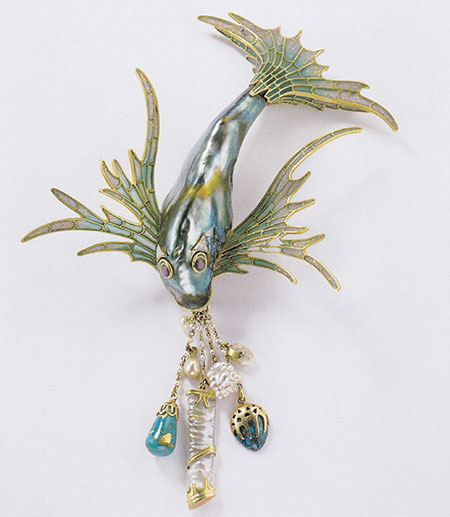 |
| Bodice ornament, gold with enamel, turquoise, abalone pearl and mother-of-pearl. By George Fouquet, Paris, ca. 1900–01. On loan from the Sparkasse Pforheim Calw Art Foundation. (Photo: Rudiger Floter © ADAGP, Paris and DACS, London 2013, courtesy V&A Museum) |
With the Renaissance, and attendant affluence, pearls are to be found in the portraits of the rich and powerful, portraits that are displayed in the exhibition. “Pearls” also includes examples of jewelry and more from the 17th, 18th and 19th centuries. Delicate Art Nouveau creations of the turn of the 20th century will contrast the opulence of the past and future. (A Nouveau-era tiara, fashioned in the likeness of a semicircular branch of forget-me-nots, was beautifully executed by Paul Gabriel Liénard, Paris, 1905. The branch is gold, the leaves and petals are of horn, with pearls and diamonds playing the part of buds and pistils.) Also exhibited will be examples from India, China, Japan and Russia. Even melo pearls will be represented, by a pair of melo and brown diamond earrings.
The exhibition is up through January 19, 2014. A catalogue, by Beatriz Chadour-Sampson and Hubert Bari, should be available via U.S. booksellers in early October. See information on the book here. [back to top]
Mineralientage München 50th Munich Mineral Show
October 25–27, 2013
Pala International will be selling and exhibiting
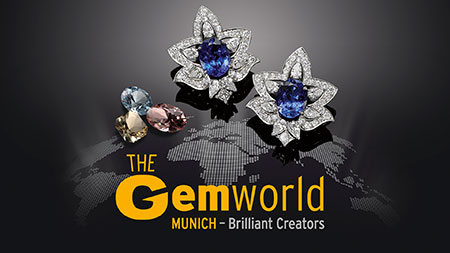 |
Pala International will be sharing space with Alain Martaud at this year’s Munich Show.
When: October 25–27, 2013
Where: Munich Trade Fair Centre
Hours:
Friday, October 25: 9:00 AM – 7:00 PM (Trade only)
Saturday, October 26: 9:00 AM – 7:00 PM
Sunday, October 27: 9:00 AM – 6:00 PM
Booth: International Mineral Pavilion, Hall A6 Booth 29; sharing with Alain Martaud Minéraux
This year’s special exhibit—in honor of the show’s jubilee year—is titled “Gold.” It will feature the “Ausrox Gold Nugget” (world’s third biggest, 23.26 kg, 22 x 24 x 16 cm), “Screaming Man” (from Kurnalpi in Western Australia, 20.32 x 7.62 x 5.08 cm), and “Camel” (from Widgiemootha in Western Australia, 7 x 16.5 x10.16 cm). This exhibit will be covered in the Theme Book, a high-quality hardcover, which will include the show catalog. Both publications will be delivered from the show store beginning October 1.
As usual, there are many activities for the junior set, such as gemstone faceting, but another activity is available to children of all ages—if you are visually impaired, that is. The “Comprehending Stones” exhibit, presented by Mr. and Mrs. Schwinghammer, is hands-on, “from the edgy surface of a pyrite to the soft texture of a soapstone.”
For more information visit the show website. See the Pala International Show Schedule for future events.
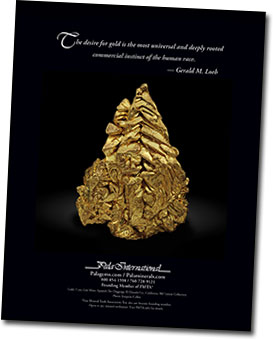 |
| See our ad in this year’s program. This “Christmas Tree” gold specimen will be displayed as part of the Munich Show’s special exhibit, “Gold.” This specimen is featured in an 1886 catalogue, “Collection of Minerals of A. Dohrmann, Esq., Catalogued by S. H. & H. Chapman.” We will profile this specimen in our October 1 edition of Pala Mineralis. |
[back to top]
Lady Heart Diamond Collection
Natural History Museum of Los Angeles County
One need not leave Southern California to take in some nice eye candy. The Natural History Museum of Los Angeles has extended its exhibition of five colored diamonds of different hues. “Only five?,” you may ask. The Lady Heart Diamond Collection is remarkable because it pairs the rarity of colored diamonds with the rarity of the diamond shape itself. Allow the collection’s designer, Bernard Bachoura, to explain.
While the diamond is in the rough, the final shape of the stone is determined by the diamond cutter based on which shape will best maximize carat weight, symmetry, and value. The unusual heart shape requires the cutter to sacrifice significant carat weight in order to achieve the desired result. It makes the heart shape a risk the cutter must be certain he or she is willing to take.
Each diamond in the collection has receive a grade by GIA of Fancy Vivid color, the best for a colored diamond. The exhibition has been extended through December 1, 2013.
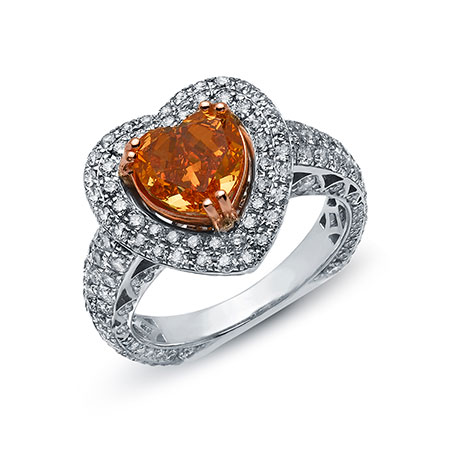 |
| The Lady Orquidea is a 2.00-carat Fancy Vivid Orange diamond heart mounted in a heart shaped bezel accented with pave white diamonds. Vivid orange diamonds are believed to be the rarest of the colored diamonds. Pure orange natural diamonds are extremely scarce and can only be classified as such if there is no trace of brown in the stone. (Photo courtesy Natural History Museum of Los Angeles County) |
If you can’t make it to the museum, peruse associate curator Eloïse Gaillou’s blog entry on the exhibition. Also see her entry on “The Mystery of the Ring,” tracing back the origin of a gift to the museum, supposedly itself a gift from Catherine the Great to one of her maids of honor.
We should note here that Carl and Bill Larson thought that Eloise’s presentation at the AFG jubilee celebration was one of the finest lectures (and all were fine)—brilliantly photographed and documented with excellent science to back up all her points. [back to top]
Seine-sational Events and Figures in Gemological History
French fête for 50 years
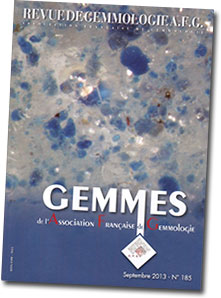 |
As we announced in July, Pala International’s Bill Larson was a featured presenter at the 13th (50th anniversary) Rendez-vous Gemmologiques de Paris on September 6. The sponsoring organization, Association Française de Gemmologie (AFG), celebrates its 50th year in 2013. So it’s only appropriate that the organization would mark the occasion with a list of fifty figures and events that have shaped the history of gems since antiquity. The finalists were chosen from a list of 193 nominees, all of which are listed in the September 2013 edition of the organization’s “Revue.” The list follows, in chronological order.
Ancient Civilizations to the Renaissance
Aristotle and Theophrastos; Pliny the Elder; Pedanius Dioscorides; Pyrgoteles and Dioscorides of the Aegean; Abū al-Rayhān Muhammad ibn Ahmad al-Bīrūnī; Navaratna Jewelry and Ratnapariska of Buddhabhatta; Louis van Berquem and Antwerp Diamond Center; Medici and Farnese Dynasties; Emeralds of Muisca and Pedro Fernández de Valenzuela Sotomayor; Bernardino de Sahagún and the Aztecs.
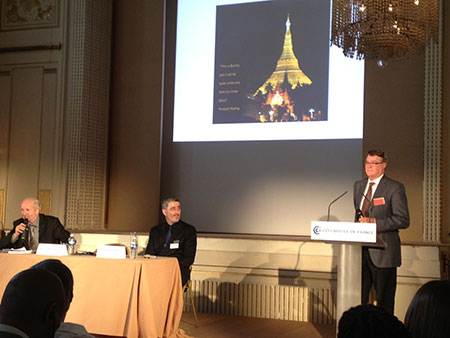 |
| Mogok au Paris. Bill Larson is introduced by AFG president Didier Giard as fellow presenter Vincent Pardieu looks on. Larson’s topic was “The Mythic Valley of Mogok,” the famed valley of gemstones that now is felt to be endangered. (Photo: Jeanne Larson) |
Period of Scientific Discovery
Anselmus Boëtius de Boodt; Jean-Baptiste Tavernier; René-Just Haüy and Jean-Baptiste Louis Romé de l’isle; Antoine Laurent de Lavoisier and Louis-Nicolas Vauquelin; Jacques-Joseph Ebelmen and Paul-Gabriel Hautefeuille & A. Perrey; The Discovery of Diamond Deposits in South Africa; René J. Lalique; Edmond Frémy and Auguste Victor Louis (de) Verneuil; Edwin W. Streeter; Kokishi Mikimoto; George Frederick Kunz; India; Tolkowsky Family; Alfred Antoine François Lacroix; Tullie Cornthwaite Wollaston; Louis Marie Auguste Boutan; Chandrasekhara Venkata Rāman and Leonid Isaakovich Mandelstam; Georg O. Wild; Eduard J. Gübelin; Basil William Anderson; Russian Diamonds; Richard T. Liddicoat; Synthetic Diamonds; John Sinkankas; Robert Webster; Campbell Bridges; Jacques Cassedanne; The Tucson Show; Joel Arthur Rosenthal; Kurt Nassau; Robert Wan; ICA (International Colored Gemstone Association); John Ilmarii Koivula; Henry A. Hänni; Emmanuel Fritsch; Richard W. Hughes; l’École de Nancy; HPHT (High Pressure High Temperature) Diamonds; Corundum Treatment; Laboratories, Tools Essential to the Gemstone Industry; Gemological Treasures from around the World.
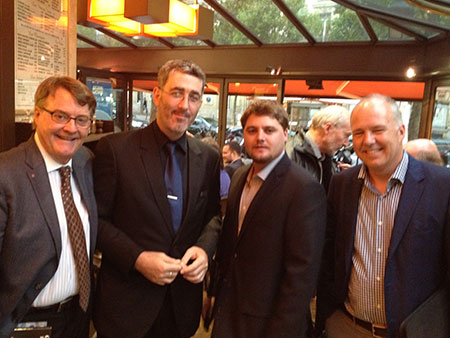 |
| Four tenors? From left, Bill Larson, presenter Vincent Pardieu (Senior Manager Field Gemology of GIA Laboratory, Bangkok), Carl Larson and presenter Hanco Zwaan, Director of Netherlands Gemmological Laboratory). (Photo: Jeanne Larson) |
See the final program for the lineup of the meeting. The description of Bill Larson’s talk bears translation.
William Larson « La mythique vallée de Mogok ». Bill Larson, le célèbre Président de Palagems.com a sillonné durant de nombreuses années de manière intensive tous les sites de la vallée de Mogok.
William Larson “The mythical valley of Mogok.” Bill Larson, the famed President of Palagems.com toured for many years intensively all sites in the valley of Mogok.
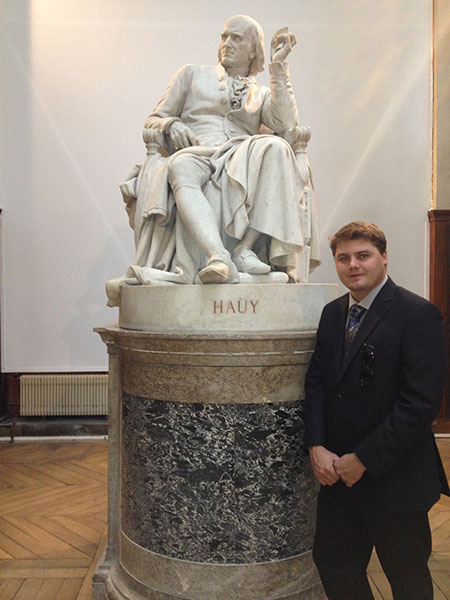 |
| At the foot of the Master. Pala International’s Carl Larson remains in Paris, working on a project at the Muséum national d’Histoire naturelle. Carl is to examine the collection of René Just Haüy, the père of modern crystallography, and No. 12 in AFG’s Top 50. He will compare the collection’s labels and their data against his own inspection. |
[back to top]
Sight and Sound in Denver
Art and music pay tribute to the near and distant past
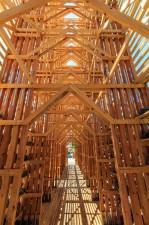  |
| Architectural art. Thumbnail images of Mine Pavilion from a larger collection by photographer Ryan Dravitz, from his blog entry at DenverUrbanism. |
Attendees of the gem and mineral shows in Denver, which wound down this past weekend, might have noticed a curious structure in the parkway of Speer Boulevard at Larimer, just north of the Convention Center. Mine Pavilion is a site-specific architectural sculpture by art and architecture studio Pezo von Ellrichshausen, based in Concepción, Chile’s second largest city.
The work, which uses beetle-kill wood, was erected in conjunction with the second Biennial of the Americas, which bills itself as “an international festival of ideas, art, and culture.” Beyond that, people (pundits included) might have trouble explaining the event, but even detractors like Westword’s Michael Paglia praised the art choices (see “This year’s Biennial fizzled rather than sizzled”). Describing Mine Pavilion, Paglia wrote, “This multi-story wooden structure, set on a bed of rocks, manages to simultaneously refer to the state’s history and function as a non-objective sculpture.” Biennial co-curator Paul Anderson tells it this way:
To drivers on Speer Boulevard, it is a billboard. To pedestrians walking along Larimer, it is a tunnel. Its height and proportions make it a tower. Its suspended floor and intermediary site make it a bridge. Its beetle kill pine facade and structural detailing make it a mining building. The pavilion’s schizophrenia is subtle. Its diverse architectural genetics are integrated so coherently that at a glance, it appears to be a single, pure gesture. The project is also slyly contextual.
Every typological reference has defined the site at one time or another. Denver was a mining settlement in 1858, when General William Larimer staked a square mile claim on the very same piece of land. Gold panning prospectors gathered around Larimer, forming Denver City. Today, the tower is the elemental feature of the area.
Anderson also sees the structure as a bridge connecting the ivory tower of academia—the Auraria campus, west of Speer is home to three schools—with “the vibrant and fluid fabric of the city.”
Another bridge of sorts had its premier the week of the Denver gem and mineral shows. Formations, the first symphony by CU composer Jeffrey Nytch, spans time, space, intellect and emotions through its four movements: Orogenies, Rush!, Requiems, and Majesties. Commissioned by the Geological Society of America, based in Boulder, and the Boulder Philharmonic, which inaugurated the work, Nytch’s symphony celebrates the GSA’s 125th anniversary.
 |
| Sight and sound. Composer and geologist Jeffrey Nytch takes you through the four movements of Symphony No. 1: Formations via video blog. |
The idea for the symphony was Nytch’s “crazy idea,” as he told the journal Nature. The composer, who also holds a degree in geology, heard about the GSA anniversary, and approached the Philharmonic. As Nytch put it, the commission became the perfect “keystone” event for the celebration.
The first movement (a term never more aptly applied), “Orogenies,” takes the listener through the foundation-laying (geological, musical) of Precambrian geology and three musical climaxes, portraying three mountain-building events, ending in an extended, quiet coda reflecting 500 million years of relative quiet. Being present for the premier, I found the movement to be plainly evocative, but it ended on an extremely tender note, with a musical ghost image that made for listener expectation regarding the second movement, “Rush!" Here fiddle tunes, rising and fizzling (Nytch’s term), recall the waves of prospectors, first in Pike’s Peak and later in Cripple Creek. We hear the miners’ pans against the whooshes (all the brass blown with open lips—you have to hear it!) depicting hydrothermic intrusions, the “geologic process that formed most of the mineral deposits in the region,” per Nytch. The movement closes with two violent events: the “thundering of the Cripple Creek Diatreme, an explosive volcano that created Colorado’s richest deposits of precious metals” and the crack of gunshots from Colorado’s labor wars in the mines. (A local historian told me that in Cripple Creek, the workers sabotaged the smelting operation by forcing the kiln to cool with ore still in it, thus turning the furnace into a monument to the rebelliousness of the workers.)
The third movement, “Requiems,” is an elegy to the Cretaceous, during which the tropical flora laid down their lives that we might enjoy ours, in a comfort supplied largely by their remains. It was the most compelling, musically and intellectually (to this erstwhile Christian), and evidently dearest to the composer. Some animated movement amongst the winds (measuring up favorably against the Benjamin Britten “Sea Interludes” from Peter Grimes, which began the program) captured the tranquility of forest and lagoon. A eerily vocalized trombone solo near the end at once soothed and quickened the heart. Movement 4, “Majesties,” closed the symphony, reprising themes from before, devoted to describing the formation of our Rocky Mountains. All in all, a thirty-minute homage to eons of events, and one deserving a wider audience.
GIA Sponsorship a First
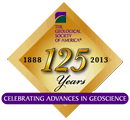 |
Don’t forget “the main event.” As we announced last month, the Geological Society of America is holding its 125th Anniversary Annual Meeting and Expo in Denver, October 27–30, 2013. For the first time at a GSA meeting, GIA is sponsoring a topical session. “Gemological Research in the 21st Century: Characterizing Diamonds and other Gem Minerals,” featuring a powerhouse roster.
The abstracts are now online for Day 1 (Tuesday session #218) and Day 2 (Wednesday session #375, including a paper by Palagems Reflective Index contributor Elise Skalwold).
Scheduled for the session are James E. Shigley (GIA), Dona M. Dirlam (GIA), George R. Rossman (Caltech), George E. Harlow (American Museum of Natural History), William B. Simmons (University of New Orleans), Frank Hawthorne (University of Manitoba). The description of the session reads: Gemstones are the most recognized, sought after, and highly valued of all minerals. This session will focus on characterizing the properties of gems, documenting their conditions of formation, and improving the means of their identification. [back to top]
InColor Covers Sinkankas Symposium
While waiting for the proceedings to be released from this year’s Sinkankas Symposium, check out the Summer 2013 edition of ICA’s quarterly journal, InColor, for an overview of the occasion. Presenting on the topic of Ruby were some of the top experts on the subject. (Note that the e-version of the journal may not load easily in all Web browsers.)
Also of interest to colored gemstone enthusiasts is the cover story, “Carranza: The Myth and the Industry,” profiling the late “emerald czar” Victor Carranza, who passed away last April.
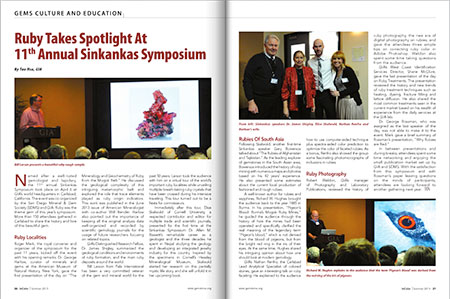 |
[back to top]
Pala International News
Pala’s Featured Stones: Phenomenal Ruby and Chrysoberyl
Phenomenals seem to be making a subtle resurgence amongst gem connoisseurs. These colorful and magical jewels engage the senses and help us appreciate the dynamic chemistry and physics at work within the crystallized oddities. A feast for the eyes and a puzzle for the intellect.
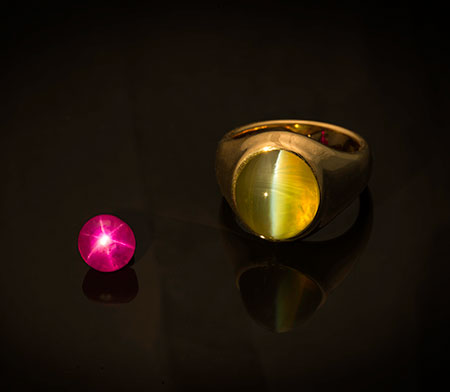 |
| The star: 5.85-carat Burmese ruby, 8.93 x 9.11 x 6.26 mm (Inv. #19983). The eye: Estimated over 20-carat Sri Lankan chrysoberyl 15.25 x 13.7 x 10.4 mm. Click to enlarge. (Photo: Mia Dixon) |
This Burmese star ruby exhibits a blazing, slightly pink, red hue with good translucency. On top of the exquisite color lies an exceptional asterism with six well-defined and positioned rays.
This cat’s eye seems to capture the best of a fine chrysoberyl. It displays a warm and pure milk-and-honey effect separated by a sharp white eye. This gem is also transparent, with only subtle internal graining tracing some of the structure. The stone is set in 18-karat gold with a precision bezel.
Interested? Select the inventory number above, call or email us to inquire. [back to top]
The Vanishing Tribes of Burma
Three-day exhibition the prelude to an important gift
It seems to be all Burma all the time here at Pala International these days. No sooner had Bill Larson delivered his presentation on Mogok in Paris, when he flew directly to Denver to present on Mogok and Burma jadeite at the Mile High Chapter of the GIA Alumni Association last Tuesday, to an appreciative audience of about 35—including Peter Maciulaitis, Bill’s roommate from his Colorado School of Mines days. The two hadn’t seen each other in 45 years! (The school’s museum has begun display of the Miss America crown, crafted of a variety of colored stones in a columbine design.) Then on Saturday, Bill presented on Burma at the Denver Gem and Mineral Show to a room of about 45.
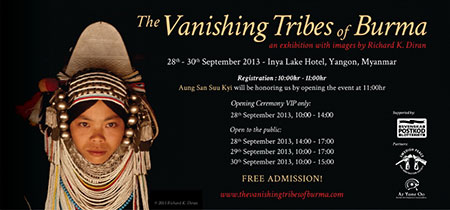 |
| Invitation for the exhibition. (Click to enlarge) Richard Diran actually is a Renaissance man. As well as being a writer (in varied forms) and photographer, Diran is a gemstone connoisseur. He also is a fine sculptor and painter whose work tells stories, depicting states of life and death, heart and mind. View examples on his website. |
Bill now prepares for his 34th trip to Burma later this month with collectors George Hickox and Jon Sigerman. Upon their arrival in Yangon they will attend an invitation-only reception on September 28 for Bill’s longtime friend, the acclaimed author and photographer Richard K. Diran, who is presenting a three-day exhibition, “The Vanishing Tribes of Burma.” Invitees will be honored by Aung San Suu Kyi, who will open the event.
Richard Diran’s photographs literally are a snapshot in time. His work represents the most comprehensive collection of visual documentation of Burma’s ethnic tribes whose cultural traditions, as portrayed in Diran’s images, are in many cases a thing of the past. The exhibition is funded by The Swedish Postcode Lottery, which routinely donates to charitable efforts; it is sponsored by The Swedish Peace and Arbitration Society in conjunction with Ar Yone Oo, a social development association in Burma. The aim of all is “to bring the issue of national reconciliation to the public eye through the inspiring images of the ethnic diversity in the region,” according to an announcement.
The exhibition is open to the public (see above link for details). After the event, the entire collection will be donated to the National Museum, in Yangon, so that future generations will have access to them. [back to top]
Industry News
Burma Bits
Border Boom
 |
| Dusting off another danburite. Our photographer Mia Dixon found this lovely stone languishing, and gave it a close-up for Old Stock… New Pix. Inv. #21165 from Burma. |
Burma’s border trade was up $391 million for the first five months of the fiscal year (April–August) over the same period last year, according to local media, as reported by the Shanghai Daily last week. Some of that figure would be due to sales of jade. (Total trade resulted in a deficit, however, April–July, per Mizzima news.)
The border also was the focus of an August 28 story in The Irrawaddy about the Central Economic Zone project being planned for Muse, which sits near the Burma–China border in northern Shan State. It is the most important border trading point between the two countries. Land is being snatched up by Burmese and Chinese businesspeople, causing real estate prices to rival those of the desirable areas of Yangon. The development is slated to include jade trading shops as well as hotels, supermarkets, recreation facilities and high-rise business buildings.
The government is sending mobile teams to the trading points in order to halt illegal trade, according to the Shanghai Daily story. The success of such interdiction, however, is debatable. Eleven Media Group (EMG) reported last week that a paltry $80,000 (80 million kyat) worth of smuggled jade had been seized in Muse on September 3.
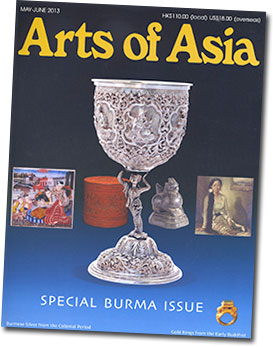 |
| From the bookshelf. The May/June edition of Arts of Asia contains articles on the other “gems” from Burma: colonial silver, lacquer, painting, gold rings and more. |
Contributing to the black market trade may be Burma’s “commercial” tax, as explained in a Myanmar Times story on September 1. Unlike income tax (tax on revenue minus expenses), commercial tax is levied on a company’s revenue, period. But it is not charged on the export of goods, with the exception of jade and gemstones (at 30%), lumber, natural gas and oil. Interestingly, the commercial tax rate for manufacturer to wholesaler usually is higher than from wholesaler to retailer.
Mogok Readies for Tourism
Interested parties have been visiting the ruby land of Mogok for months now, and this fact was reported in two recent stories. On August 22, EMG gave a brief overview of the opening up of Mrauk Oo (home of many notable stone pagodas from the 16th century) as well as Mogok. A Myanmar Times story last week noted that the savvy traveler should understand that luxury accommodations will not be in store: Mogok has only one hotel. The Ministry of Hotels and Tourism now is training 100 tour guides to prepare for increased demand. A local jade broker, Ko Zaw Min, remembered seeing only a single Japanese traveler in the area, who was there for a donation ceremony, and that was three years ago.
Bite-Sized Bits
- Myanmar Times: As we noted before, Burma’s gem emporia are being plagued by Chinese traders who bid high on jade and then fail to collect; Mandalay traders now are calling for new regulations to help stop the practice
- Gübelin Gem Lab: Not sure how we missed this, but in June the lab announced July seminars in Mandalay and Yangon; the lab’s summer activity there was noticed by Myanmar Times on July 29
- Shanghai Daily: “Magical green gemstone grows in popularity” this daily proclaims in its headline, September 2; you knew that, but you’ll still want to see the image of a gorgeous jadeite necklace
- The Irrawaddy: If you needed more evidence of the popularity of jade, AFP talked with Hong Kong jade dealer Li Kwong-kei, who remarked on the difficulty in obtaining high quality material
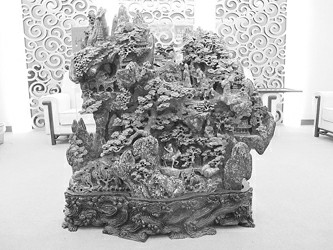 |
| From the archives. This story was reported in March 2012, but we didn’t find it stale. A purported 200-year-old carving of Burma jade, pictured above, is believed (hoped?) to have been part of the Chinese imperial collection in Beijing. Weighing a half ton and measuring 98 x 115 cm, the carving was received with skepticism when it was found by accident during an excavation in Jiangsu Province. Read more at Shanghai Daily. |
[back to top]
Books
“And the low shall be high”
Historian Paul Koudounaris finds jewels in the charnel house
Back in the 1970s your editor would browse the shops in what is now known as the “Sunset Junction” area, where Sunset meets Santa Monica Boulevards, in Los Angeles’ Silver Lake neighborhood, east of Hollywood, amid gay bars and bookshops, the fringe-y offerings of the Olio theater, and the after-hours comfort of the Crest Coffee Shop. A little jewel in that bohemian milieu was Soap Plant, the purveyor of ceramics and leatherwear (designed by the owners’ sons Peter and Billy Shire, respectively), gift and decorative items, artwork and, of course, artisanal soaps.
By the 1980s, Soap Plant had moved west, to the trendy section of Melrose Avenue, into larger digs. Then-sole owner Billy Shire opened the midway-esque Wacko next door and, finally La Luz de Jesus Gallery, upstairs from Soap Plant. (The three enterprises moved back to East Hollywood in 1995.) We spent many an afternoon thumbing through the gallery’s selection of books on art, religion and culture, and dropped many a dollar there. Shire knew what he liked and he (and curator Robert Lopez) exhibited it with relish. For some artists, this was their introduction to viewers who would become their first patrons. A case in point is painter Manuel Ocampo, who, according to a 1988 story in the Los Angeles Times, was so poor he painted over used canvases, before having his first show at La Luz. Ocampo has gone on to be featured in the Bienniales of Kwangju, Lyon, Berlin and Venice.
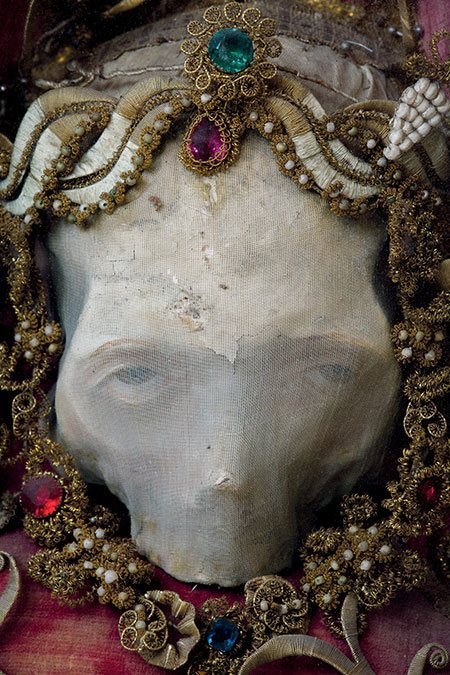 |
| In addition to its four complete skeletons, the church in Roggenburg, Germany, owns a pair of skull relics. This one was given the generic name of Deodatus as its identity was unknown. (Photo © 2013 Paul Koudounaris, courtesy Thames & Hudson) |
Given Shire’s predilection for the unusual, it’s no wonder that he would embrace the work of Paul Koudounaris. Schooled as an art historian, Dr. Koudounaris has studied the practice of decorating skeletal remains with jewels and other objects, a phenomenon that has taken him from the catacombs of Paris to the killing fields of Phnom Penh. This historian’s photographs and commentary are the subject of two books, both published by Thames & Hudson: Empire of Death: A Cultural History of Ossuaries and Charnel Houses (2011) and Heavenly Bodies: Cult Treasures and Spectacular Saints from the Catacombs (2013).
In the context of 16th century Europe, these bejeweled bones found their way from underground tombs in Rome that contained what were thought to be the remains of early Christian martyrs. Discovered in 1578, there were thousands of them, and some also were thought to be saints. These skeletons were removed to Catholic churches in Europe and given an earthly, yet heavenly, reward, replacing the relics of saints that were destroyed during the Protestant Reformation of years before.
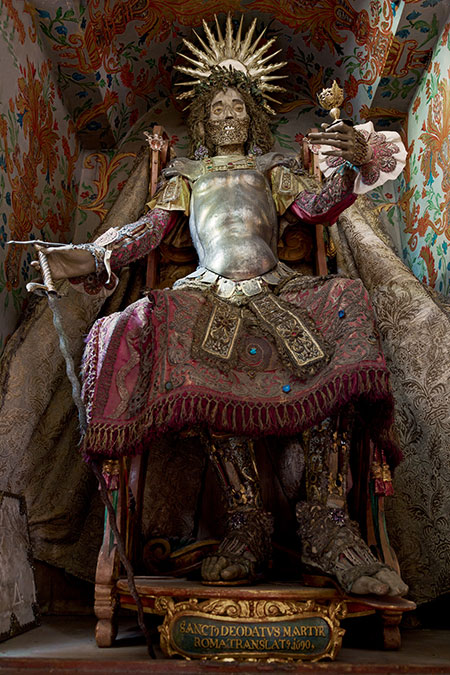 |
| The relic of St. Deodatus in Rheinau, Switzerland, is an example of an unusual reconstruction technique in which a wax face was molded over the upper half of the skull and a fabric wrap used to create a mouth. (Photo © 2013 Paul Koudounaris, courtesy Thames & Hudson) |
We haven’t seen either book yet, so we can’t comment on the nature of the gemstones employed in the often elaborate disposition of the departed. But interested parties will have a chance to ask the author about this in person at autumn appearances at Oxford University (Sept. 18) and a handful of U.S. dates in October from New York to San Diego. And, yes, at La Luz de Jesus in East Hollywood, which will mark the opening of an exhibition of Koudounaris’s photographs. For details, see the author’s website. [back to top]
— End September Newsletter • Published 9/17/13 —
Note: Palagems.com selects much of its material in the interest of fostering a stimulating discourse on the topics of gems, gemology, and the gemstone industry. Therefore the opinions expressed here are not necessarily those held by the proprietors of Palagems.com. We welcome your feedback.
